Sustainable Masonry Retrofitting and Upgrading Techniques: A Review
Abstract
Highlights
- Sustainable Retrofitting Techniques: This review paper critically examines various fiber retrofitting and upgrading techniques: (1) mechanical, (2) thermal, and (3) integrated (structural and thermal).
- TRM vs. FRP Systems: Textile reinforced mortar (TRM) systems offer superior performance compared with fiber reinforced polymer (FRP) systems in masonry retrofitting, due to better material compatibility, breathability, fire resistance, and lower environmental impact.
- Integrated Retrofitting: Combining structural and thermal retrofitting techniques, such as in the case of natural fiber TRM (NFTRM), enhances the load-bearing capacity of masonry walls while improving their insulation properties, addressing both seismic resilience and energy efficiency. Notably, standards/guidelines are absent for NFTRM system applications.
- Challenges and Future Research: Further research is needed into fiber treatments, hybrid reinforcement strategies, and the durability and moisture absorption problems.
- Sustainability: The innovative application/use of natural fiber-based building materials can support global sustainability goals. Notably, it can help in reducing dependence on synthetic materials and minimize the carbon footprint.
- Cost-Effectiveness: Integrated (structural and thermal) retrofitting approaches, such as the use of NFTRM, aim to lower long-term maintenance costs and extend the lifespan of buildings.
- Seismic Resilience and Energy Efficiency: Improved structural and thermal performance (separately or via integrated retrofitting approaches) of retrofitted masonry walls addresses vulnerabilities in unreinforced masonry (URM) structures, an essential factor for buildings in earthquake-prone areas and for reducing overall energy consumption.
Abstract
1. Introduction
2. Methodology Applied in This Review Paper
- Considering the research scope and objectives, this study focuses on sustainable retrofitting and upgrading techniques for masonry walls. It provides a systematic review of existing research, experimental studies, and international standards related to masonry retrofitting. Comparative studies on the mechanical and thermal performance of different reinforcement building materials and testing techniques are analyzed.
- Classification of various retrofitting techniques is discussed in this review paper, focusing on (i) mechanical/structural retrofitting, considering tests performed at small or structural scale, (ii) thermal retrofitting to improve energy efficiency with fiber insulation materials, and (iii) integrated (structural and thermal) retrofitting, combining mechanical and thermal enhancements.
- Various experimental TRM-system reinforced masonry wall testing methodologies are also considered, including (i) diagonal tension (shear) tests, (ii) in-plane cyclic tests, and (iii) compressive strength tests.
- A comparative study between man-made and natural fiber-based TRM is also provided at the end of this paper, primarily focusing on analyzing TRM systems using man-made fibers (like glass, carbon, basalt, and steel textiles) and natural fibers (like jute, hemp, flax, etc.).
3. Different Fiber Retrofitting/Upgrading Techniques
- (a)
- Use and Application of Fiber and Fiber Products:
- Fiber insulation materials: mainly man-made (glass [44]) or natural fibers (sourced from animals: sheep wool [45,46], and sourced from plants: jute [47], hemp [48], sisal [49], banana [50] etc.), used to produce insulation materials with the aim to be used for enhancing the energy efficacy of buildings.
- Fiber composite mortar: in this case, fibers (such as carbon [51], basalt [52], glass [53], polypropylene [54] or natural fibers [55]) are integrated into the mortar to enhance its mechanical properties, such as strength, ductility, and durability, and/or to improve masonry structures’ thermal performance (particularly in the case of natural fiber composite mortar).
- Fiber-reinforced polymer (FRP) [56]: FRP systems are widely used for retrofitting masonry and concrete structures. Notably, FRP is known to have a high strength-to-weight ratio, providing excellent tensile and compressive strength. Also, FRPs are lightweight and enhance the seismic resistance and load-bearing capacity of structures.
- Textile-reinforced mortar (TRM) [57]: TRM, or fiber-reinforced cementitious matrix (FRCM), uses textiles (often carbon, basalt, or natural fibers like jute) embedded in a cementitious matrix to strengthen masonry and concrete. Unlike FRP, TRM avoids the use of polymers, making it more compatible with the structure’s substrate, especially in terms of breathability and long-term durability.
- (b)
- Based on the Final Objective of Retrofitting/Upgrading:
- Thermal reinforcement: as a way to improve the thermal performance of buildings, which helps prevent heat loss or enhances thermal insulation. This is typically achieved through the use of specialized composites and mortars [58], which include thermally insulating materials (e.g., fiber-made insulation panels [44,45]).
3.1. Natural Fiber Reinforcement
3.1.1. Mechanical Properties
3.1.2. Thermal Properties
| Insulation Materials | TCavg. (W/mK) |
|---|---|
| Jute, wool, and polyester and co–polyester (Figure 6) | 0.043 |
| Jute and clay | 0.116 |
| Loofa and clay | 0.108 |
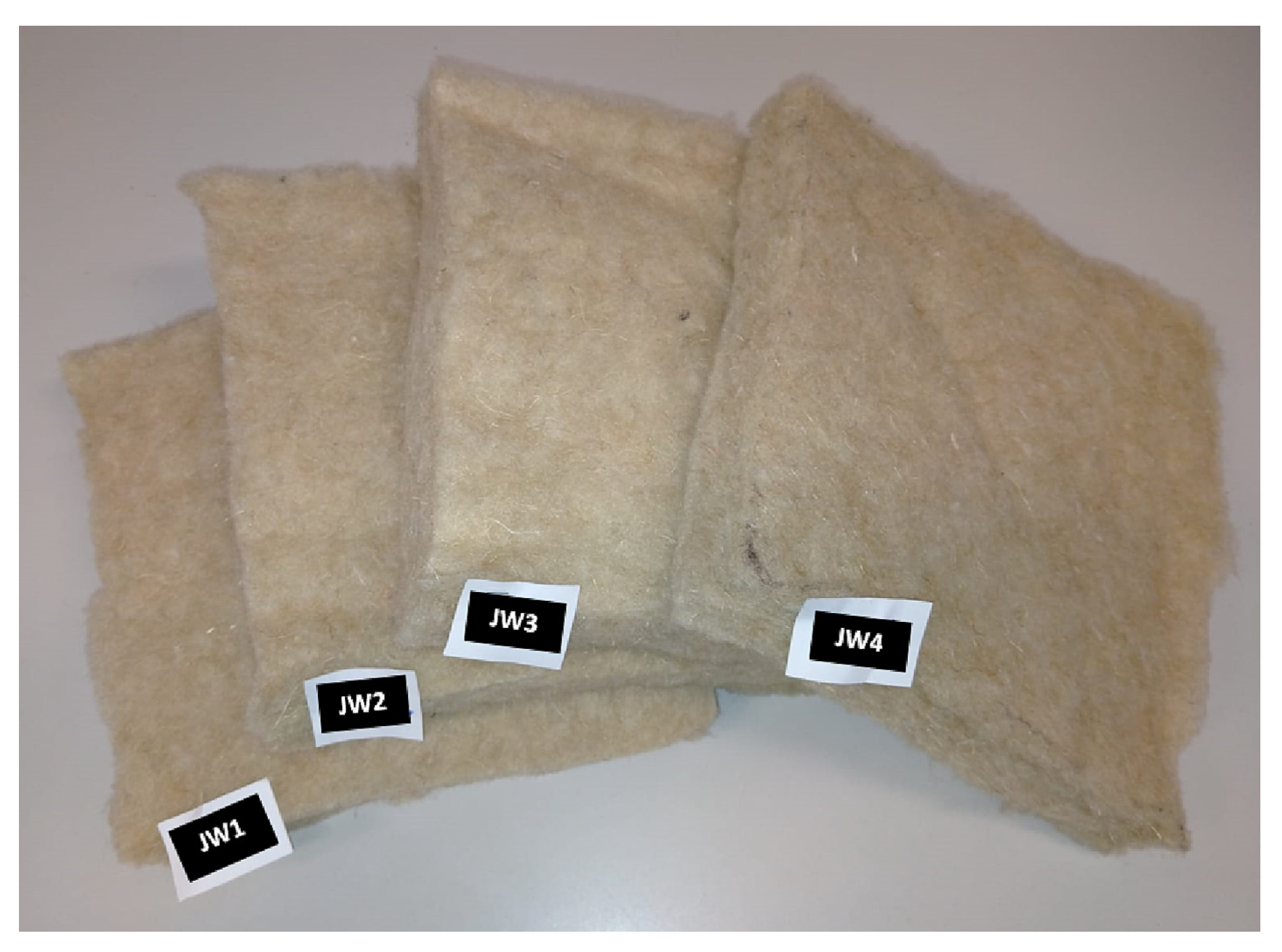
3.1.3. Thermo-Mechanical Properties
3.2. Natural Fiber Reinforced Polymers (NFRP)
3.3. Natural Fiber Textile Reinforced Mortar (NF-TRM)
- Apply TRM reinforcement symmetrically on both faces of the masonry wall.
- It is preferable to apply the TRM over the entire surface of the wall; however, in certain cases, application in strips may be considered.
- The fabric used should have a grid orientation aligned both vertically and horizontally.
- For crack mitigation, the fabric should be applied in the orthogonal direction relative to the cracks.
- It is important to note that, for the design of shear strengthening, only the fiber area aligned parallel to the direction of the shear force should be taken into account.
- If strengthening is applied to just one side, connectors may be used, and a reduction of at least 30% in masonry shear strength must be taken into account.
3.3.1. Types of Shear-Bond Failure for TRM Strengthening
3.3.2. Natural Fiber TRM Application
- Durability Issues: One of the major problems of natural fibers in a TRM system is durability, which has not been extensively studied yet. Therefore, effective treatment protocols are needed to enhance their longevity and performance.
- Crimping Effects: The crimping effect in natural fibers affects their tensile response, requiring to be taken into account for effective composite use;
- Dimensional Stability: importantly, natural fibers are not uniform in nature and therefore, ensuring the dimensional stability of natural fibers in TRMs is another significant challenge;
- Empirical Fabrication: The current production of natural TRMs predominantly relies on empirical methods rather than a systematic engineering design approach;
- Compatibility with Matrix Materials: It is crucial for optimal performance that the appropriate choice of the type of matrix that should be compatible with the natural fibers in terms of stiffness and strength.
- Lack of Rational Design Methodology: A rational, theoretical approach to designing natural TRM composites is necessary, as there are currently no standardized methodologies for accurately predicting properties.
- Need for Further Research: Existing research in this field is limited; therefore, future research should focus on improving the performance and design of natural fiber TRM systems.
4. International Standards for Masonry Testing Methods
- The ASTM E519/E519M-22 standard [112] provides a comprehensive method for testing the diagonal tension (shear) strength of masonry assemblages, emphasizing consistent and precise evaluation of their structural performance (Figure 18). The test involves applying a compression load diagonally to a masonry specimen, resulting in tension-induced failure along the diagonal. This methodology allows precise evaluation of shear stress and strain, interpreting the impact of masonry unit type and mortar composition on material properties. The standard highlights the requirements for test preparation like specimen dimensions, curing conditions, number of specimens to be tested, and dimensioning of testing apparatus, in order to ensure consistency and reliability of results. Testing machines must apply continuous loads, while optional instrumentation can measure strain for a more detailed stress–strain analysis. The results include calculated shear stress, strain, modulus of rigidity, and failure modes. Developed with internationally recognized principles, the standard supports dual-unit (SI and inch-pound) measurements and ensures safety considerations during testing. It serves as a vital tool for researchers and engineers in evaluating masonry for structural behavior.
- The ASTM E2126-19 standard [113] provides detailed test methods for evaluating the shear resistance of vertical elements in lateral force-resisting systems under cyclic (reversed) loading conditions. This standard is designed to assess the performance of structural systems, such as walls, partitions, and other vertical assemblies, when subjected to repeated lateral loads that simulate seismic or wind forces. The test methods involve the controlled application of cyclic lateral loads to measure deformation, energy dissipation, stiffness degradation, and ultimate strength. The standard highlights reversed cyclic loading and helps simulate the structural response during load reversals. It provides guidelines for sample preparation, testing equipment, and loading protocols. The results outline essential parameters, including load–displacement behavior, hysteresis characteristics, and ductility. These parameters are essential for studying the seismic performance and ensuring the reliability of lateral force-resisting structures. This standard is extensively utilized in structural design and quality assurance to guarantee building safety and ensure compliance with established design criteria.
- The EN 1052-1:2011 [114] is a European standard that specifies the method to determine the compressive strength of masonry. It is mainly used for evaluating the load-bearing capacity and structural integrity of masonry elements, such as walls made from materials like clay bricks, concrete blocks, and natural stones, bonded with mortar. The standard gives guidance on how to prepare the test specimens, the procedure for applying compression loads uniformly, and the calculation of compressive strength, which is computed based on the maximum load at failure. This standard has been used to ensure that masonry structures comply with safety and performance standards, contributing to the overall stability and durability of buildings.
- The RILEM LUMB6 guidelines [115] provides recommendations from the International Union of Laboratories and Experts in Construction Materials, Systems, and Structures (RILEM) for conducting diagonal tensile strength tests on small masonry wall specimens. Unlike national standards such as those from the British Standards Institution (BSI), RILEM guidelines offer internationally recognized best practices. The LUMB6 procedure evaluates the shear strength of masonry by applying compression loads along a diagonal axis of wall specimens, typically measuring 500 mm × 500 mm. Key steps include preparing and curing the specimens, setting up the test frame with diagonal load application through steel plates or loading shoes, and gradually applying the load until failure, usually indicated by diagonal cracking. As recommended, the maximum load at failure is recorded, and the diagonal tensile strength is calculated using the load, specimen dimensions, and contact area. This testing method is essential for understanding the tensile and shear properties of masonry, which are crucial for designing and evaluating structures, especially under lateral loads such as seismic forces.
5. Masonry Wall Testing
5.1. Diagonal Tension (Shear) Test
5.2. In-Plane Cycle Test
5.3. Compressive Strength Test
6. Masonry Wall Structural Upgrade with Natural Fiber TRM Systems and Testing
- Durability Issues: One of the major problems of natural fibers in a TRM system is durability, which has not been extensively studied. Therefore, effective treatment protocols are necessary to enhance longevity and performance;
- Crimping Effects: The crimping effect in natural fibers affects their tensile response, requiring taking into account for effective use of composites;
- Dimensional Stability: Natural fibers are not uniform in nature, so ensuring the dimensional stability of natural fibers in TRMs is another significant challenge;
- Empirical Fabrication: The current production of natural TRM predominantly relies on empirical methods rather than a systematic engineering design approach;
- Compatibility with Matrix Materials: It is crucial for optimal performance that the appropriate choice of the type of matrix should be compatible with the natural fibers in terms of stiffness and strength.
- Lack of Rational Design Methodology: A rational, theoretical approach to designing natural TRM composites is necessary, as there are currently no standardized methodologies for accurately predicting properties.
- Need for Further Research: Existing research in this field is limited; therefore, future research should focus on improving performance and designing natural fiber TRM systems.
7. Integrated TRM Retrofitting/Upgrading: Man-Made vs. Natural Fiber
7.1. Man-Made Fiber for Integrated (Structural and Thermal) TRM Retrofitting/Upgrading
7.2. Natural Fiber for Integrated TRM Retrofitting/Upgrading
8. Discussion and Observations
9. Conclusions
Author Contributions
Funding
Acknowledgments
Conflicts of Interest
References
- CORDIS-EU, Boosting the Renovation Rate of existing Masonry Buildings in Earthquake-Prone EU Regions, Seismic Plus EneRgy Upgrading of Masonry Buildings Using Advanced Materials, Horizon 2020. 2020. Available online: https://cordis.europa.eu/article/id/430350-boosting-the-renovation-rate-of-existing-masonry-buildings-in-earthquake-prone-eu-regions (accessed on 19 January 2025).
- EN 1998-1; Eurocode 8, Design of Structures for Earthquake Rsistance. Part 1: General Rules, Seismic Actions and Rules for Buildings. National Standards Authority of Ireland: Dublin, Ireland, 2004.
- EN 832:1998; Thermal Performance of Buildings-Calculation of Energy Use for Heating-Residential Buildings. European Committee for Standardization (CEN): Brussels, Belgium, 1998. Available online: https://www.cen.eu/ (accessed on 21 January 2025).
- Raoof, S.M.; Koutas, L.N.; Bournas, D.A. Textile-reinforced mortar (TRM) versus fibre-reinforced polymers (FRP) in flexural strengthening of RC beams. Constr. Build. Mater. 2017, 151, 279–291. [Google Scholar] [CrossRef]
- Torres, B.; Ivorra, S.; Baeza, F.J.; Estevan, L.; Varona, B. Textile reinforced mortars (TRM) for repairing and retrofitting masonry walls subjected to in-plane cyclic loads. An experimental approach. Eng. Struct. 2021, 231, 111742. [Google Scholar] [CrossRef]
- Rajak, D.; Pagar, D.; Menezes, P.; Linul, E. Fiber-Reinforced Polymer Composites: Manufacturing, Properties, and Applications. Polymers 2019, 11, 1667. [Google Scholar] [CrossRef] [PubMed]
- Johnson, W.S.; Masters, J.E.; Wilson, D.W.; Chin, J.; Nguyen, T.; Aouadi, K. Effects of Environmental Exposure on Fiber-Reinforced Plastic (FRP) Materials Used in Construction. J. Compos. Technol. Res. 1997, 19, 205. [Google Scholar] [CrossRef]
- Gkournelos, P.D.; Triantafillou, T.C.; Bournas, D.A. Seismic upgrading of existing masonry structures: A state-of-the-art review. Soil Dyn. Earthq. Eng. 2022, 161, 107428. [Google Scholar] [CrossRef]
- CNR-DT 215/2018; Guide for the Design and Construction of Externally Bonded Fibre Reinforced Inorganic Matrix Systems for Strengthening Existing Structures. CNR: Rome, Italy, 2019. Available online: https://www.cnr.it/en/node/12827 (accessed on 26 March 2024).
- Kapsalis, P.; El Kadi, M.; Vervloet, J.; De Munck, M.; Wastiels, J.; Triantafillou, T.; Tysmans, T. Thermomechanical Behavior of Textile Reinforced Cementitious Composites Subjected to Fire. Appl. Sci. 2019, 9, 747. [Google Scholar] [CrossRef]
- Fossetti, M.; Minafò, G. Strengthening of Masonry Columns with BFRCM or with Steel Wires: An Experimental Study. Fibers 2016, 4, 15. [Google Scholar] [CrossRef]
- Kamrava, A.R.; Najafgholipour, M.A.; Fathi, F.; Dehghan, S.M. An experimental study on the in-plane behavior of unreinforced masonry walls with an opening strengthened using steel fiber reinforced concrete overlays. J. Build. Eng. 2021, 36, 102084. [Google Scholar] [CrossRef]
- Akhoundi, F.; Vasconcelos, G.; Lourenço, P. In-Plane Behavior of Infills using Glass Fiber Shear Connectors in Textile Reinforced Mortar (TRM) Technique. Int. J. Struct. Glass Adv. Mater. Res. 2018, 2, 1–14. [Google Scholar] [CrossRef][Green Version]
- Giese, A.C.H.; Giese, D.N.; Dutra, V.F.P.; Da Silva Filho, L.C.P. Flexural behavior of reinforced concrete beams strengthened with textile reinforced mortar. J. Build. Eng. 2021, 33, 101873. [Google Scholar] [CrossRef]
- Pham, H.H.; Dinh, N.H.; Kim, S.-H.; Park, S.-H.; Choi, K.-K. Tensile behavioral characteristics of lightweight carbon textile-reinforced cementitious composites. J. Build. Eng. 2022, 57, 104848. [Google Scholar] [CrossRef]
- Prota, A.; Marcari, G.; Fabbrocino, G.; Manfredi, G.; Aldea, C. Experimental In-Plane Behavior of Tuff Masonry Strengthened with Cementitious Matrix–Grid Composites. J. Compos. Constr. 2006, 10, 223–233. [Google Scholar] [CrossRef]
- Faella, C.; Martinelli, E.; Nigro, E.; Paciello, S. Shear capacity of masonry walls externally strengthened by a cement-based composite material: An experimental campaign. Constr. Build. Mater. 2010, 24, 84–93. [Google Scholar] [CrossRef]
- Guo, L.; Deng, M.; Li, R.; Li, T.; Dong, Z. Shear strengthening of RC short columns with CFRP grid-reinforced FRC matrix: Cyclic loading tests. J. Build. Eng. 2022, 47, 103915. [Google Scholar] [CrossRef]
- Li, S.; Chen, X.; Liu, Z.; Lu, Y.; Wang, H. Axial behavior of pre-damaged RC columns strengthened with CFRP textile grid-reinforced ECC matrix composites. J. Build. Eng. 2023, 73, 106813. [Google Scholar] [CrossRef]
- Wang, J.; Wan, C.; Shen, L.; Zeng, Q.; Ji, X. Compressive behavior of masonry columns confined with basalt textile-reinforced concrete. J. Build. Eng. 2023, 75, 107019. [Google Scholar] [CrossRef]
- Ibrahim, M.; Galal, M.; Kohail, M.; Rashad, A.; ElShafie, H. Behaviour of unreinforced masonry walls retrofitted by using basalt textile reinforced mortar. Eng. Struct. 2022, 260, 114201. [Google Scholar] [CrossRef]
- Pérez-Pinedo, L.; Sandoval, C.; Alvarado, R.; Vargas, L.; Calderón, S.; Bernat, E. Seismic strengthening of partially grouted masonry walls with openings: Evaluation of ferrocement and BTRM solutions. J. Build. Eng. 2024, 88, 109235. [Google Scholar] [CrossRef]
- Furtado, A.; Rodrigues, H.; Arêde, A. Cantilever flexural strength tests of masonry infill walls strengthened with textile-reinforced mortar. J. Build. Eng. 2021, 33, 101611. [Google Scholar] [CrossRef]
- García, G.; Cabrera, R.; Rolón, J.; Pichardo, R.; Thomas, C. Natural fibers as reinforcement of mortar and concrete: A systematic review from Central and South American regions. J. Build. Eng. 2024, 98, 111267. [Google Scholar] [CrossRef]
- Abdalla, J.A.; Hawileh, R.A.; Bahurudeen, A.; Jyothsna, G.; Sofi, A.; Shanmugam, V.; Thomas, B.S. A comprehensive review on the use of natural fibers in cement/geopolymer concrete: A step towards sustainability. Case Stud. Constr. Mater. 2023, 19, e02244. [Google Scholar] [CrossRef]
- Alazzawi, S.; Mahmood, W.A.; Shihab, S.K. Comparative study of natural fiber-Reinforced composites for sustainable thermal insulation in construction. Int. J. Thermofluids 2024, 24, 100839. [Google Scholar] [CrossRef]
- Majumder, A.; Stochino, F.; Frattolillo, A.; Valdes, M.; Martinelli, E. Natural Fiber Textile Reinforced Mortar (NFTRM) for Integrated Masonry Upgrading. Procedia Struct. Integr. 2024, 64, 1880–1887. [Google Scholar] [CrossRef]
- de Beus, N.; Carus, M.; Martha, B. Natural Fibres Show Outstandingly Low CO2 Footprint Compared to Glass and Mineral Fibres. 2019. Available online: https://renewable-carbon.eu/news/natural-fibres-show-outstandingly-low-co2-footprint-compared-to-glass-and-mineral-fibres/ (accessed on 19 January 2025).
- Kurien, R.A.; Anil, M.M.; Mohan, S.L.S.; Thomas, J.A. Natural fiber composites as sustainable resources for emerging applications- a review. Mater. Today Proc. 2023, in press. [Google Scholar] [CrossRef]
- Mah, C.M.; Fujiwara, T.; Ho, C.S. Environmental impacts of construction and demolition waste management alternatives. Chem. Eng. Trans. 2018, 63, 343–348. [Google Scholar] [CrossRef]
- Shi, J.; Lu, Y.; Zhu, R.; Liu, Y.; Zhang, Y.; Lv, Q. Experimental evaluation of fracture toughness of bamboo fiber reinforced high performance lightweight aggregate concrete. Eng. Struct. 2023, 297, 117028. [Google Scholar] [CrossRef]
- Soleymani, A.; Najafgholipour, M.A.; Johari, A.; Dooshabi, A. The diagonal shear behavior of masonry walls fabricated with historical lime-based mortar and retrofitted with near surface mounted method. Structures 2024, 59, 105795. [Google Scholar] [CrossRef]
- Valenza, A.; Fiore, V.; Nicolosi, A.; Rizzo, G.; Scaccianoce, G.; Di Bella, G. Effect of sheep wool fibres on thermal-insulation and mechanical properties of cement matrix. Acad. J. Civ. Eng. 2015, 33, 40–45. [Google Scholar] [CrossRef]
- Benmansour, N.; Agoudjil, B.; Gherabli, A.; Kareche, A.; Boudenne, A. Thermal and mechanical performance of natural mortar reinforced with date palm fibers for use as insulating materials in building. Energy Build. 2014, 81, 98–104. [Google Scholar] [CrossRef]
- Raut, A.N.; Gomez, C.P. Thermal and mechanical performance of oil palm fiber reinforced mortar utilizing palm oil fly ash as a complementary binder. Constr. Build. Mater. 2016, 126, 476–483. [Google Scholar] [CrossRef]
- Tang, L.; Liu, T.; Sun, P.; Wang, Y.; Liu, G. Sisal fiber modified construction waste recycled brick as building material: Properties, performance and applications. Structures 2022, 46, 927–935. [Google Scholar] [CrossRef]
- Hari, R.; Mini, K.M. Mechanical and durability properties of sisal-Nylon 6 hybrid fibre reinforced high strength SCC. Constr. Build. Mater. 2019, 204, 479–491. [Google Scholar] [CrossRef]
- Teixeira, F.P.; Cardoso, D.C.T.; De Andrade Silva, F. On the shear behavior of natural curauá fabric reinforced cement-based composite systems. Eng. Struct. 2021, 246, 113054. [Google Scholar] [CrossRef]
- Alam, M.A.; Al Riyami, K.; Bakkar, S. Optimization of kenaf fibre reinforced polymer laminate for shear strengthening of RC beams using embedded connector. Eng. Struct. 2021, 232, 111790. [Google Scholar] [CrossRef]
- Helaili, S.; Chafra, M.; Chevalier, Y. Natural fiber alfa/epoxy randomly reinforced composite mechanical properties identification. Structures 2021, 34, 542–549. [Google Scholar] [CrossRef]
- Elfordy, S.; Lucas, F.; Tancret, F.; Scudeller, Y.; Goudet, L. Mechanical and thermal properties of lime and hemp concrete (“hempcrete”) manufactured by a projection process. Constr. Build. Mater. 2008, 22, 2116–2123. [Google Scholar] [CrossRef]
- Ferrara, G.; Caggegi, C.; Martinelli, E.; Gabor, A. Shear capacity of masonry walls externally strengthened using Flax-TRM composite systems: Experimental tests and comparative assessment. Constr. Build. Mater. 2020, 261, 120490. [Google Scholar] [CrossRef]
- Menna, C.; Asprone, D.; Durante, M.; Zinno, A.; Balsamo, A.; Prota, A. Structural behaviour of masonry panels strengthened with an innovative hemp fibre composite grid. Constr. Build. Mater. 2015, 100, 111–121. [Google Scholar] [CrossRef]
- Bjånesøy, S.; Heinonen, J.; Ögmundarson, Ó.; Árnadóttir, Á.; Marteinsson, B. Fiberglass as a Novel Building Material: A Life Cycle Assessment of a Pilot House. Architecture 2022, 2, 690–710. [Google Scholar] [CrossRef]
- Hetimy, S.; Megahed, N.; Eleinen, O.A.; Elgheznawy, D. Exploring the potential of sheep wool as an eco-friendly insulation material: A comprehensive review and analytical ranking. Sustain. Mater. Technol. 2024, 39, e00812. [Google Scholar] [CrossRef]
- Dénes, T.-O.; Iştoan, R.; Tǎmaş-Gavrea, D.R.; Manea, D.L.; Hegyi, A.; Popa, F.; Vasile, O. Analysis of Sheep Wool-Based Composites for Building Insulation. Polymers 2022, 14, 2109. [Google Scholar] [CrossRef] [PubMed]
- Majumder, A.; Achenza, M.; Mastino, C.C.; Baccoli, R.; Frattolillo, A. Thermo-acoustic building insulation materials fabricated with recycled fibers–Jute, Wool and Loofah. Energy Build. 2023, 293, 113211. [Google Scholar] [CrossRef]
- Majumder, A.; Canale, L.; Mastino, C.C.; Pacitto, A.; Frattolillo, A.; Dell’Isola, M. Thermal Characterization of Recycled Materials for Building Insulation. Energies 2021, 14, 3564. [Google Scholar] [CrossRef]
- Ouhaibi, S.; Mrajji, O.; El Wazna, M.; Gounni, A.; Belouaggadia, N.; Ezzine, M.; Lbibb, R.; El Bouari, A.; Cherkaoui, O. Sisal-fibre based thermal insulation for use in buildings. Adv. Build. Energy Res. 2022, 16, 489–513. [Google Scholar] [CrossRef]
- Manohar, K.; Adeyanju, A. A Comparison of Banana Fiber Thermal Insulation with Conventional Building Thermal Insulation. BJAST 2016, 17, 1–9. [Google Scholar] [CrossRef]
- Safiuddin, M.; Abdel-Sayed, G.; Hearn, N. Absorption and Strength Properties of Short Carbon Fiber Reinforced Mortar Composite. Buildings 2021, 11, 300. [Google Scholar] [CrossRef]
- Ralegaonkar, R.; Gavali, H.; Aswath, P.; Abolmaali, S. Application of chopped basalt fibers in reinforced mortar: A review. Constr. Build. Mater. 2018, 164, 589–602. [Google Scholar] [CrossRef]
- Fang, Y.; Chen, B.; Oderji, S.Y. Experimental research on magnesium phosphate cement mortar reinforced by glass fiber. Constr. Build. Mater. 2018, 188, 729–736. [Google Scholar] [CrossRef]
- Baykara, H.; Cornejo, M.H.; Espinoza, A.; García, E.; Ulloa, N. Preparation, characterization, and evaluation of compressive strength of polypropylene fiber reinforced geopolymer mortars. Heliyon 2020, 6, e03755. [Google Scholar] [CrossRef]
- Majumder, A.; Stochino, F.; Frattolillo, A.; Valdes, M.; Mancusi, G.; Martinelli, E. Jute fiber-reinforced mortars: Mechanical response and thermal performance. J. Build. Eng. 2023, 66, 105888. [Google Scholar] [CrossRef]
- Van Den Einde, L.; Zhao, L.; Seible, F. Use of FRP composites in civil structural applications. Constr. Build. Mater. 2003, 17, 389–403. [Google Scholar] [CrossRef]
- Kouris, L.A.S.; Triantafillou, T.C. State-of-the-art on strengthening of masonry structures with textile reinforced mortar (TRM). Constr. Build. Mater. 2018, 188, 1221–1233. [Google Scholar] [CrossRef]
- Jiang, D.; Lv, S.; Cui, S.; Sun, S.; Song, X.; He, S.; Zhang, J.; An, P. Effect of thermal insulation components on physical and mechanical properties of plant fibre composite thermal insulation mortar. J. Mater. Res. Technol. 2020, 9, 12996–13013. [Google Scholar] [CrossRef]
- Majumder, A.; Stochino, F.; Frattolillo, A.; Valdes, M.; Martinelli, E. Jute Fiber Composite Mortars: Sustainable Solutions for Thermo-Mechanical Retrofitting in Construction. Procedia Struct. Integr. 2024, 64, 1444–1451. [Google Scholar] [CrossRef]
- Majumder, A.; Stochino, F.; Fraternali, F.; Martinelli, E. Seismic and Thermal Retrofitting of Masonry Buildings with Fiber Reinforced Composite Systems: A State of the Art Review. Int. J. Struct. Glass Adv. Mater. Res. 2021, 5, 41–67. [Google Scholar] [CrossRef]
- Girijappa, Y.G.T.; Rangappa, S.M.; Parameswaranpillai, J.; Siengchin, S. Natural Fibers as Sustainable and Renewable Resource for Development of Eco-Friendly Composites: A Comprehensive Review. Front. Mater. 2019, 6, 226. [Google Scholar] [CrossRef]
- Mesbah, A.; Morel, J.C.; Walker, P.; Ghavami, K. Development of a Direct Tensile Test for Compacted Earth Blocks Reinforced with Natural Fibers. J. Mater. Civ. Eng. 2004, 16, 95–98. [Google Scholar] [CrossRef]
- Sanjay, M.R.; Madhu, P.; Jawaid, M.; Senthamaraikannan, P.; Senthil, S.; Pradeep, S. Characterization and properties of natural fiber polymer composites: A comprehensive review. J. Clean. Prod. 2018, 172, 566–581. [Google Scholar] [CrossRef]
- Kumar, A.S.; Gopi, R. Strength and durability studies on paver blocks with rice husk ash as partial replacement of cement. Mater. Today Proc. 2022, 52, 683–688. [Google Scholar] [CrossRef]
- Jethy, B.; Paul, S.; Naik, B. Effect of utilization of rice husk ash on hardened properties of recycled concrete aggregate. Mater. Today Proc. 2022, 59, 1625–1635. [Google Scholar] [CrossRef]
- Maier, M.; Javadian, A.; Saeidi, N.; Unluer, C.; Taylor, H.K.; Ostertag, C.P. Mechanical Properties and Flexural Behavior of Sustainable Bamboo Fiber-Reinforced Mortar. Appl. Sci. 2020, 10, 6587. [Google Scholar] [CrossRef]
- Sassu, M.; Giresini, L.; Bonannini, E.; Puppio, M. On the Use of Vibro-Compressed Units with Bio-Natural Aggregate. Buildings 2016, 6, 40. [Google Scholar] [CrossRef]
- Formisano, A.; Dessì, E.; Landolfo, R. Mechanical-physical experimental tests on lime mortars and bricks reinforced with hemp. In Proceedings of the International Conference of Computational Methods in Sciences and Engineering 2017, Thessaloniki, Greece, 21–25 April 2017; p. 090006. [Google Scholar] [CrossRef]
- Azhary, K.E.; Chihab, Y.; Mansour, M.; Laaroussi, N.; Garoum, M. Energy Efficiency and Thermal Properties of the Composite Material Clay-straw. Energy Procedia 2017, 141, 160–164. [Google Scholar] [CrossRef]
- Fatma, N.; Allègue, L.; Salem, M.; Zitoune, R.; Zidi, M. The effect of doum palm fibers on the mechanical and thermal properties of gypsum mortar. J. Compos. Mater. 2019, 53, 2641–2659. [Google Scholar] [CrossRef]
- Vėjelis, S.; Vaitkus, S.; Skulskis, V.; Kremensas, A.; Kairytė, A. Performance Evaluation of Thermal Insulation Materials from Sheep’s Wool and Hemp Fibres. Materials 2024, 17, 3339. [Google Scholar] [CrossRef]
- Cetiner, I.; Shea, A.D. Wood waste as an alternative thermal insulation for buildings. Energy Build. 2018, 168, 374–384. [Google Scholar] [CrossRef]
- Raza, M.; Abdallah, H.A.; Abdullah, A.; Abu-Jdayil, B. Date Palm Surface Fibers for Green Thermal Insulation. Buildings 2022, 12, 866. [Google Scholar] [CrossRef]
- Aigbomian, E.P.; Fan, M. Development of Wood-Crete building materials from sawdust and waste paper. Constr. Build. Mater. 2013, 40, 361–366. [Google Scholar] [CrossRef]
- Batool, F.; Islam, K.; Cakiroglu, C.; Shahriar, A. Effectiveness of wood waste sawdust to produce medium- to low-strength concrete materials. J. Build. Eng. 2021, 44, 103237. [Google Scholar] [CrossRef]
- Sathiparan, N.; Rupasinghe, M.N.; Pavithra, B.H.M. Performance of coconut coir reinforced hydraulic cement mortar for surface plastering application. Constr. Build. Mater. 2017, 142, 23–30. [Google Scholar] [CrossRef]
- Kalali, A.; Kabir, M.Z. Cyclic behavior of perforated masonry walls strengthened with glass fiber reinforced polymers. Sci. Iran. 2012, 19, 151–165. [Google Scholar] [CrossRef]
- Gattesco, N.; Boem, I. Experimental and analytical study to evaluate the effectiveness of an in-plane reinforcement for masonry walls using GFRP meshes. Constr. Build. Mater. 2015, 88, 94–104. [Google Scholar] [CrossRef]
- Stratford, T.; Pascale, G.; Manfroni, O.; Bonfiglioli, B. Shear Strengthening Masonry Panels with Sheet Glass-Fiber Reinforced Polymer. J. Compos. Constr. 2004, 8, 434–443. [Google Scholar] [CrossRef]
- Alecci, V.; Barducci, S.; D’Ambrisi, A.; De Stefano, M.; Focacci, F.; Luciano, R.; Penna, R. Shear capacity of masonry panels repaired with composite materials: Experimental and analytical investigations. Compos. Part B Eng. 2019, 171, 61–69. [Google Scholar] [CrossRef]
- Rahman, A.; Ueda, T. In-Plane Shear Performance of Masonry Walls after Strengthening by Two Different FRPs. J. Compos. Constr. 2016, 20, 04016019. [Google Scholar] [CrossRef]
- Can, Ö. Investigation of seismic performance of in-plane aligned masonry panels strengthened with Carbon Fiber Reinforced Polymer. Constr. Build. Mater. 2018, 186, 854–862. [Google Scholar] [CrossRef]
- Padalu, P.K.V.R.; Singh, Y.; Das, S. Out-of-plane flexural strengthening of URM wallettes using basalt fibre reinforced polymer composite. Constr. Build. Mater. 2019, 216, 272–295. [Google Scholar] [CrossRef]
- Punurai, W.; Kroehong, W.; Saptamongkol, A.; Chindaprasirt, P. Mechanical properties, microstructure and drying shrinkage of hybrid fly ash-basalt fiber geopolymer paste. Constr. Build. Mater. 2018, 186, 62–70. [Google Scholar] [CrossRef]
- Zhou, D.; Lei, Z.; Wang, J. In-plane behavior of seismically damaged masonry walls repaired with external BFRP. Compos. Struct. 2013, 102, 9–19. [Google Scholar] [CrossRef]
- ReAnIn, Global Natural Fiber-Reinforced Plastics (NFRP) Market Growth, Share, Size, Trends and Forecast (2024–2030). 2024. Available online: https://www.reanin.com/reports/global-natural-fiber-reinforced-plastics-nfrp-market (accessed on 18 January 2025).
- Kamarudin, S.H.; Basri, M.S.M.; Rayung, M.; Abu, F.; Ahmad, S.; Norizan, M.N.; Osman, S.; Sarifuddin, N.; Desa, M.S.Z.M.; Abdullah, U.H.; et al. A Review on Natural Fiber Reinforced Polymer Composites (NFRPC) for Sustainable Industrial Applications. Polymers 2022, 14, 3698. [Google Scholar] [CrossRef]
- Saba, N.; Jawaid, M.; Alothman, O.Y.; Paridah, M.; Hassan, A. Recent advances in epoxy resin, natural fiber-reinforced epoxy composites and their applications. J. Reinf. Plast. Compos. 2016, 35, 447–470. [Google Scholar] [CrossRef]
- Haghdan, S.; Smith, G.D. Natural fiber reinforced polyester composites: A literature review. J. Reinf. Plast. Compos. 2015, 34, 1179–1190. [Google Scholar] [CrossRef]
- Torres-Arellano, M.; Renteria-Rodríguez, V.; Franco-Urquiza, E. Mechanical Properties of Natural-Fiber-Reinforced Biobased Epoxy Resins Manufactured by Resin Infusion Process. Polymers 2020, 12, 2841. [Google Scholar] [CrossRef] [PubMed]
- Khalid, M.Y.; Al Rashid, A.; Arif, Z.U.; Ahmed, W.; Arshad, H.; Zaidi, A.A. Natural fiber reinforced composites: Sustainable materials for emerging applications. Results Eng. 2021, 11, 100263. [Google Scholar] [CrossRef]
- Mohammed, M.; Jawad, A.J.M.; Mohammed, A.M.; Oleiwi, J.K.; Adam, T.; Osman, A.F.; Dahham, O.S.; Betar, B.O.; Gopinath, S.C.B.; Jaafar, M. Challenges and advancement in water absorption of natural fiber-reinforced polymer composites. Polym. Test. 2023, 124, 108083. [Google Scholar] [CrossRef]
- Mohammed, M.; Rasidi, M.; Mohammed, A.; Rahman, R.; Osman, A.; Adam, T.; Betar, B.; Dahham, O. Interfacial bonding mechanisms of natural fibre-matrix composites: An overview. BioRes 2022, 17, 7031–7090. [Google Scholar] [CrossRef]
- Harle, S.M. Durability and long-term performance of fiber reinforced polymer (FRP) composites: A review. Structures 2024, 60, 105881. [Google Scholar] [CrossRef]
- Codispoti, R.; Oliveira, D.V.; Olivito, R.S.; Lourenço, P.B.; Fangueiro, R. Mechanical performance of natural fiber-reinforced composites for the strengthening of masonry. Compos. Part B Eng. 2015, 77, 74–83. [Google Scholar] [CrossRef]
- Khaleel, S.; Madhavi, K.; Basutkar, S.M. Mechanical characteristics of brick masonry using natural fiber composites. Mater. Today Proc. 2021, 46, 4817–4824. [Google Scholar] [CrossRef]
- Yinh, S.; Hussain, Q.; Joyklad, P.; Chaimahawan, P.; Rattanapitikon, W.; Limkatanyu, S.; Pimanmas, A. Strengthening effect of natural fiber reinforced polymer composites (NFRP) on concrete. Case Stud. Constr. Mater. 2021, 15, e00653. [Google Scholar] [CrossRef]
- Saidi, T.; Hasan, M.; Amalia, Z.; Salsabila, S. The analysis of the bond strength between natural fiber reinforced polymer (NFRP) sheets and concrete. Results Eng. 2023, 18, 101124. [Google Scholar] [CrossRef]
- Amalia, Z.; Hasan, M.; Saidi, T.; Nadia, S. Bonding behavior of pineapple and silk fiber-based NFRP on strenghthened reinforced concrete beams using direct tensile test. In Proceedings of the 3rd Aceh International Symposium on Civil Engineering (Aisce): Towards the Sustainable and Green Construction Promoting Advanced Materials and Technology for Disaster Resilient Infrastructure and Environments, Banda Aceh, Indonesia, 28–29 October 2021; p. 060005. [Google Scholar] [CrossRef]
- Papanicolaou, C.; Triantafillou, T.; Lekka, M. Externally bonded grids as strengthening and seismic retrofitting materials of masonry panels. Constr. Build. Mater. 2011, 25, 504–514. [Google Scholar] [CrossRef]
- Triantafillou, T. Textile-Reinforced Mortars (TRM): A New Generation of Composite Materials as Alternative to Fibre-reinforced Polymers (FRP) for Strengthening and Seismic Retrofitting of Structures. In Composite Materials; Nicolais, L., Meo, M., Milella, E., Eds.; Springer: London, UK, 2011; pp. 113–127. ISBN 978-0-85729-165-3. [Google Scholar] [CrossRef]
- Dalalbashi, A.; Ghiassi, B.; Oliveira, D.V. A multi-level investigation on the mechanical response of TRM-strengthened masonry. Mater. Struct. 2021, 54, 224. [Google Scholar] [CrossRef]
- Ferrara, G. Flax-TRM Composite Systems for Strengthening of Masonry: From Material Identification to Structural Behavior; Springer International Publishing: Cham, Switzerland, 2021. [Google Scholar] [CrossRef]
- Estevan, L.; Torres, B.; Baeza, F.J.; Varona, F.B.; Ivorra, S. Masonry walls strengthened with Textile Reinforced Mortars (TRM) and subjected to in-plane cyclic loads after real fire exposure. Eng. Struct. 2023, 296, 116922. [Google Scholar] [CrossRef]
- De Santis, S.; De Canio, G.; De Felice, G.; Meriggi, P.; Roselli, I. Out-of-plane seismic retrofitting of masonry walls with Textile Reinforced Mortar composites. Bull Earthq. Eng. 2019, 17, 6265–6300. [Google Scholar] [CrossRef]
- RILEM Technical Committee 232-TDT (Wolfgang Brameshuber) Recommendation of RILEM TC 232-TDT: Test methods and design of textile reinforced concrete: Uniaxial tensile test: Test method to determine the load bearing behavior of tensile specimens made of textile reinforced concrete. Mater. Struct. 2016, 49, 4923–4927. [CrossRef]
- ACI 549.4R-13; Guide to Design and Construction of Externally Bonded Fabric-Reinforced Cementitious Matrix (FRCM) Systems for Repair and Strengthening Concrete and Masonry Structures. American Concrete Institute: Farmington Hills, MI, USA, 2013.
- CNR-DT 200/2004; Guide for the Design and Construction of Externally Bonded FRP Systems for Strengthening Existing Structures. CNR: Rome, Italy, 2004.
- Kossakowski, P.G.; Wciślik, W. Fiber-Reinforced Polymer Composites in the Construction of Bridges: Opportunities, Problems and Challenges. Fibers 2022, 10, 37. [Google Scholar] [CrossRef]
- Raoof, S.M.; Bournas, D.A. TRM versus FRP in flexural strengthening of RC beams: Behaviour at high temperatures. Constr. Build. Mater. 2017, 154, 424–437. [Google Scholar] [CrossRef]
- Trochoutsou, N.; Di Benedetti, M.; Pilakoutas, K.; Guadagnini, M. Mechanical Characterisation of Flax and Jute Textile-Reinforced Mortars. Constr. Build. Mater. 2021, 271, 121564. [Google Scholar] [CrossRef]
- ASTM E519/E519M-22; Standard Test Method for Diagonal Tension (Shear) in Masonry Assemblages. ASTM International: West Conshohocken, PA, USA, 2022. [CrossRef]
- ASTM E2126-19; Standard Test Methods for Cyclic (Reversed) Load Test for Shear Resistance of Vertical Elements of the Lateral Force Resisting Systems for Buildings. ASTM International: West Conshohocken, PA, USA, 2019. [CrossRef]
- EN 1052-1:2011; Methods of Test for Masonry-Part 1: Determination of Compressive Strength. European Committee for Standardization (CEN): Brussels, Belgium, 2011.
- RILEM TC. LUM B6 Diagonal tensile strength tests of small wall specimens. In RILEM Recommendations for the Testing and Use of Constructions Materials; E & FN SPON: London, UK, 1994. [Google Scholar]
- Yu, J.-H.; Park, J.-H. Compressive and Diagonal Tension Strengths of Masonry Prisms Strengthened with Amorphous Steel Fiber-Reinforced Mortar Overlay. Appl. Sci. 2021, 11, 5974. [Google Scholar] [CrossRef]
- Thomoglou, A.K.; Karabinis, A.I. Experimental investigation of the shear strength of hollow brick unreinforced masonry walls retrofitted with TRM system. Earthq. Struct. 2022, 22, 355–372. [Google Scholar] [CrossRef]
- Longo, F.; Cascardi, A.; Lassandro, P.; Aiello, M.A. Energy and seismic drawbacks of masonry: A unified retrofitting solution. J. Build. Rehabil. 2021, 6, 31. [Google Scholar] [CrossRef]
- Elmeligy, O.; AbdelRahman, B.; Galal, K. Experimental assessment of the in-plane cyclic response of flanged partially grouted reinforced masonry shear walls failing in flexure. Eng. Struct. 2025, 322, 119089. [Google Scholar] [CrossRef]
- Mohamad, A.-B.A.E.; Chen, Z. Experimental Studies on the Behavior of a Newly-Developed Type of Self-Insulating Concrete Masonry Shear Wall under in-Plane Cyclic Loading. Appl. Sci. 2017, 7, 463. [Google Scholar] [CrossRef]
- Radovanović, Ž.; Grebović, R.S.; Dimovska, S.; Serdar, N.; Vatin, N.; Murgul, V. The Mechanical Properties of Masonry Walls-Analysis of the Test Results. Procedia Eng. 2015, 117, 865–873. [Google Scholar] [CrossRef]
- Illampas, R.; Oliveira, D.V.; Lourenço, P.B. Design of Strain-Hardening Natural TRM Composites: Current Challenges and Future Research Paths. Materials 2023, 16, 4558. [Google Scholar] [CrossRef]
- European Commission. Integrated Techniques for Seismic and Energy Retrofitting of Buildings; Joint Research Centre: Brussels, Belgium, 2021; Available online: https://ec.europa.eu/newsroom/jrc_drm/items/715185/en (accessed on 20 May 2025).
- Triantafillou, T.C.; Karlos, K.; Kefalou, K.; Argyropoulou, E. An innovative structural and energy retrofitting system for URM walls using textile reinforced mortars combined with thermal insulation: Mechanical and fire behavior. Constr. Build. Mater. 2017, 133, 1–13. [Google Scholar] [CrossRef]
- Triantafillou, T.C.; Karlos, K.; Kapsalis, P.; Georgiou, L. Innovative Structural and Energy Retrofitting System for Masonry Walls Using Textile Reinforced Mortars Combined with Thermal Insulation: In-Plane Mechanical Behavior. J. Compos. Constr. 2018, 22, 04018029. [Google Scholar] [CrossRef]
- Gkournelos, P.D.; Triantafillou, T.C.; Bournas, D.A. Integrated Structural and Energy Retrofitting of Masonry Walls: Effect of In-Plane Damage on the Out-of-Plane Response. J. Compos. Constr. 2020, 24, 04020049. [Google Scholar] [CrossRef]
- Karlos, K.; Tsantilis, A.; Triantafillou, T. Integrated Seismic and Energy Retrofitting System for Masonry Walls Using Textile-Reinforced Mortars Combined with Thermal Insulation: Experimental, Analytical, and Numerical Study. J. Compos. Sci. 2020, 4, 189. [Google Scholar] [CrossRef]
- Baek, E.; Pohoryles, D.A.; Kallioras, S.; Bournas, D.A.; Choi, H.; Kim, T. Innovative seismic and energy retrofitting of wall envelopes using prefabricated textile-reinforced concrete panels with an embedded capillary tube system. Eng. Struct. 2022, 265, 114453. [Google Scholar] [CrossRef]
- Gkournelos, P.D.; Triantafillou, T.C. Out-of-Plane Behavior of In-Plane Damaged Masonry Infills Retrofitted with TRM and Thermal Insulation. J. Compos. Constr. 2023, 27, 04023054. [Google Scholar] [CrossRef]
- Facconi, L.; Lucchini, S.S.; Minelli, F.; Grassi, B.; Pilotelli, M.; Plizzari, G.A. Innovative Method for Seismic and Energy Retrofitting of Masonry Buildings. Sustainability 2021, 13, 6350. [Google Scholar] [CrossRef]
- Furtado, A.; Rodrigues, H.; Arêde, A.; Varum, H. A experimental characterization of seismic plus thermal energy retrofitting techniques for masonry infill walls. J. Build. Eng. 2023, 75, 106854. [Google Scholar] [CrossRef]
- Stochino, F.; Majumder, A.; Frattolillo, A.; Valdes, M.; Martinelli, E. Jute fiber reinforcement for masonry walls: Integrating structural strength and thermal insulation in sustainable upgrades. J. Build. Eng. 2025, 104, 112210. [Google Scholar] [CrossRef]
- Lamichhane, N.; Lamichhane, A.; Gyawali, T.R. Enhancing mechanical properties of mortar with short and thin banana fibers: A sustainable alternative to synthetic fibers. Heliyon 2024, 10, e30652. [Google Scholar] [CrossRef]
- Çomak, B.; Bideci, A.; Bideci, Ö.S. Effects of hemp fibers on characteristics of cement based mortar. Constr. Build. Mater. 2018, 169, 794–799. [Google Scholar] [CrossRef]
- Marvila, M.T.; Azevedo, A.R.G.; Alexandre, J.; Zanelato, E.B.; Monteiro, S.N.; Cecchin, D.; Amaral, L.F. Mortars with Pineapple Fibers for Use in Structural Reinforcement. In Characterization of Minerals, Metals, and Materials 2019; Li, B., Li, J., Ikhmayies, S., Zhang, M., Kalay, Y.E., Carpenter, J.S., Hwang, J.-Y., Monteiro, S.N., Bai, C., Escobedo-Diaz, J.P., et al., Eds.; The Minerals, Metals & Materials Series; Springer International Publishing: Cham, Switzerland, 2019; pp. 721–728. ISBN 978-3-030-05748-0. [Google Scholar]
- Hwang, C.-L.; Tran, V.-A.; Hong, J.-W.; Hsieh, Y.-C. Effects of short coconut fiber on the mechanical properties, plastic cracking behavior, and impact resistance of cementitious composites. Constr. Build. Mater. 2016, 127, 984–992. [Google Scholar] [CrossRef]
- Tong, Y.; Zhang, W.; Li, M.; Ngo, T.T.; Wang, Q.; Zeng, W.; Li, B. Mechanical and thermal properties of structural lightweight bamboo fiber-reinforced insulating mortar. Case Stud. Constr. Mater. 2025, 22, e04462. [Google Scholar] [CrossRef]
- Stefanidou, M.; Kampragkou, P.; Kamperidou, V. Wood fibres as additives in mortars: A sustainable reinforcement. IOP Conf. Ser. Earth Environ. Sci. 2023, 1196, 012067. [Google Scholar] [CrossRef]
- De Silva, G.H.M.J.S.; Naveen, P. Effect of rice husk ash and coconut coir fiber on cement mortar: Enhancing sustainability and efficiency in buildings. Constr. Build. Mater. 2024, 440, 137326. [Google Scholar] [CrossRef]
- Moses, O.T. Compressive Strength Characteristics of Kenaf Fibre Reinforced Cement Mortar. Adv. Mater. 2015, 4, 6. [Google Scholar] [CrossRef][Green Version]



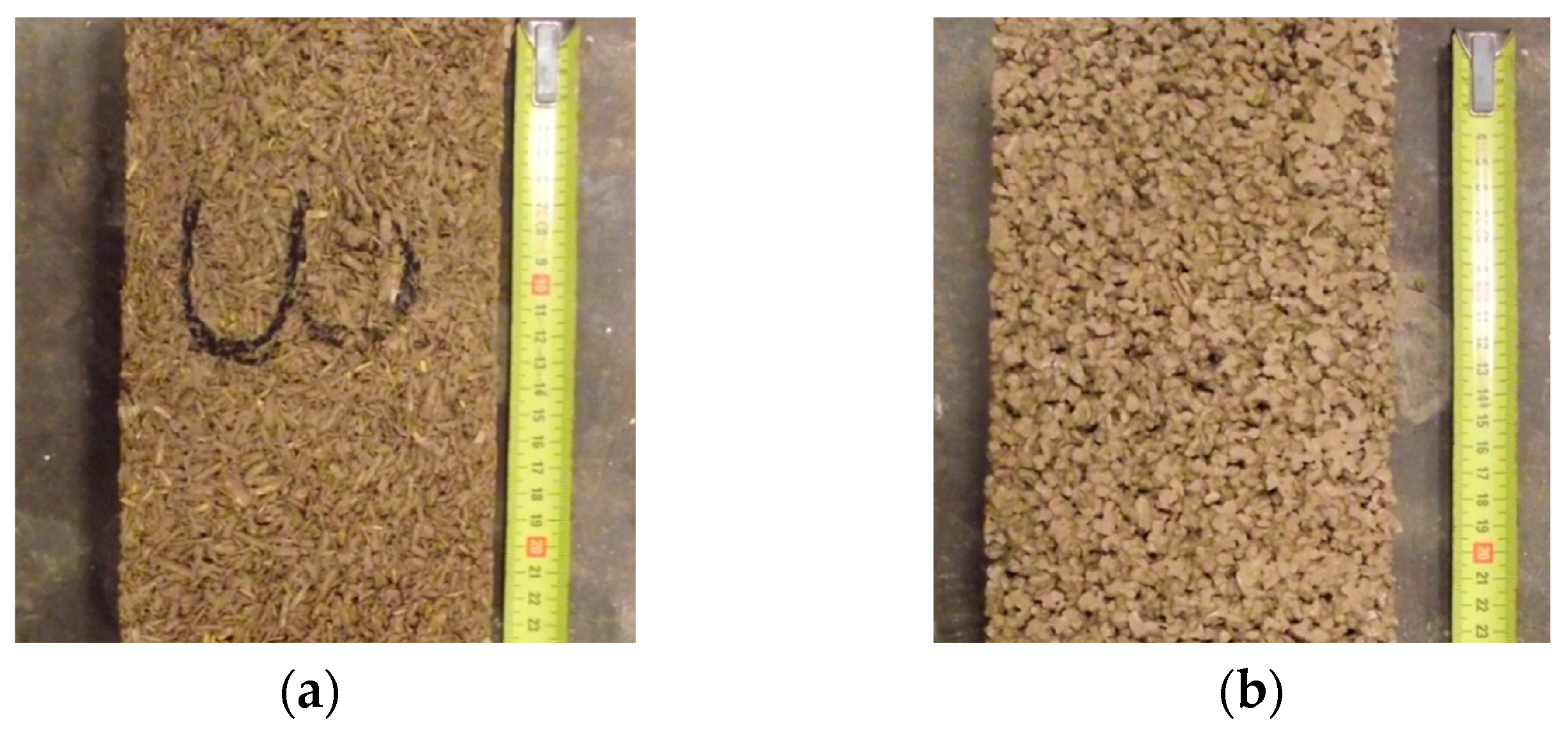



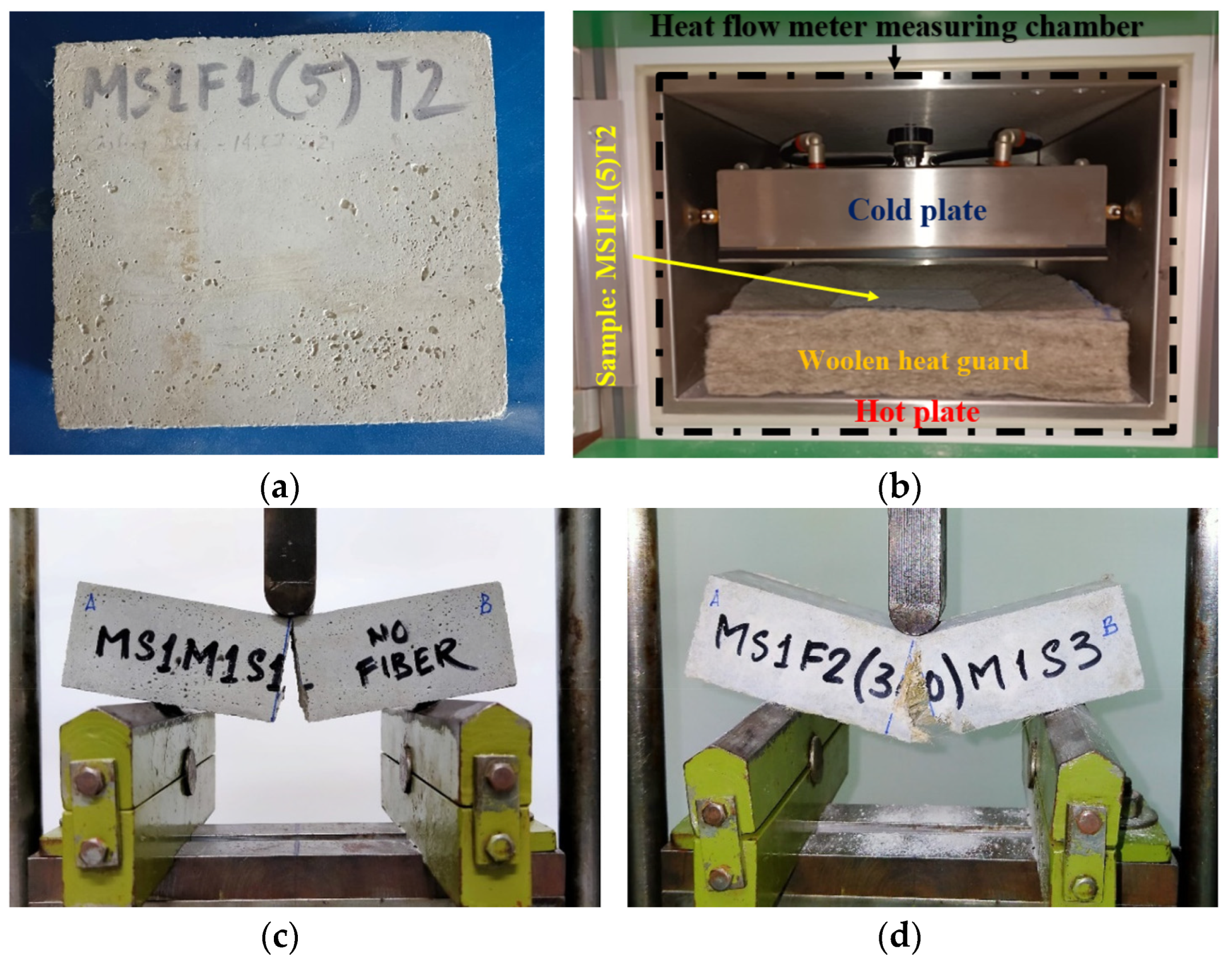

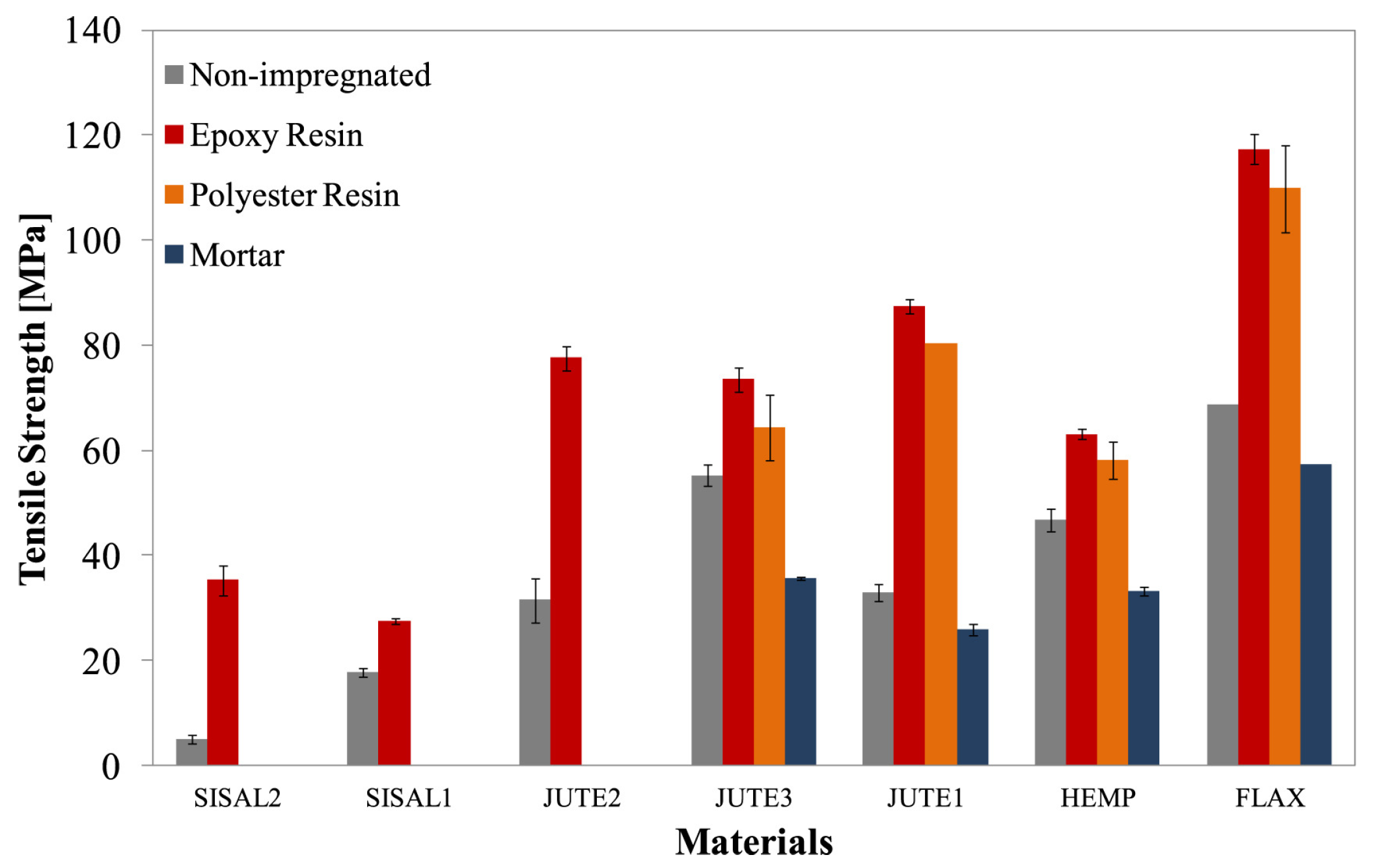
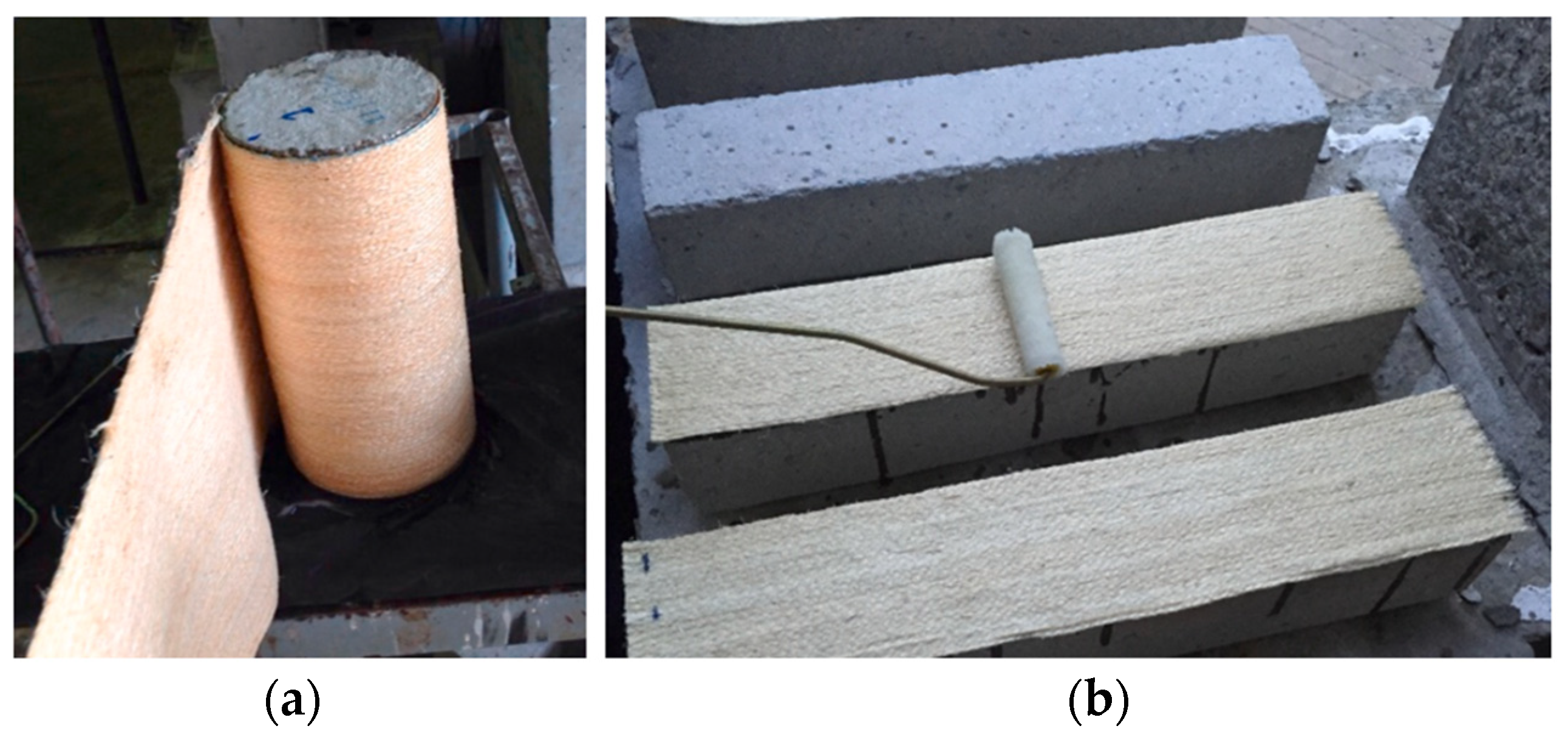


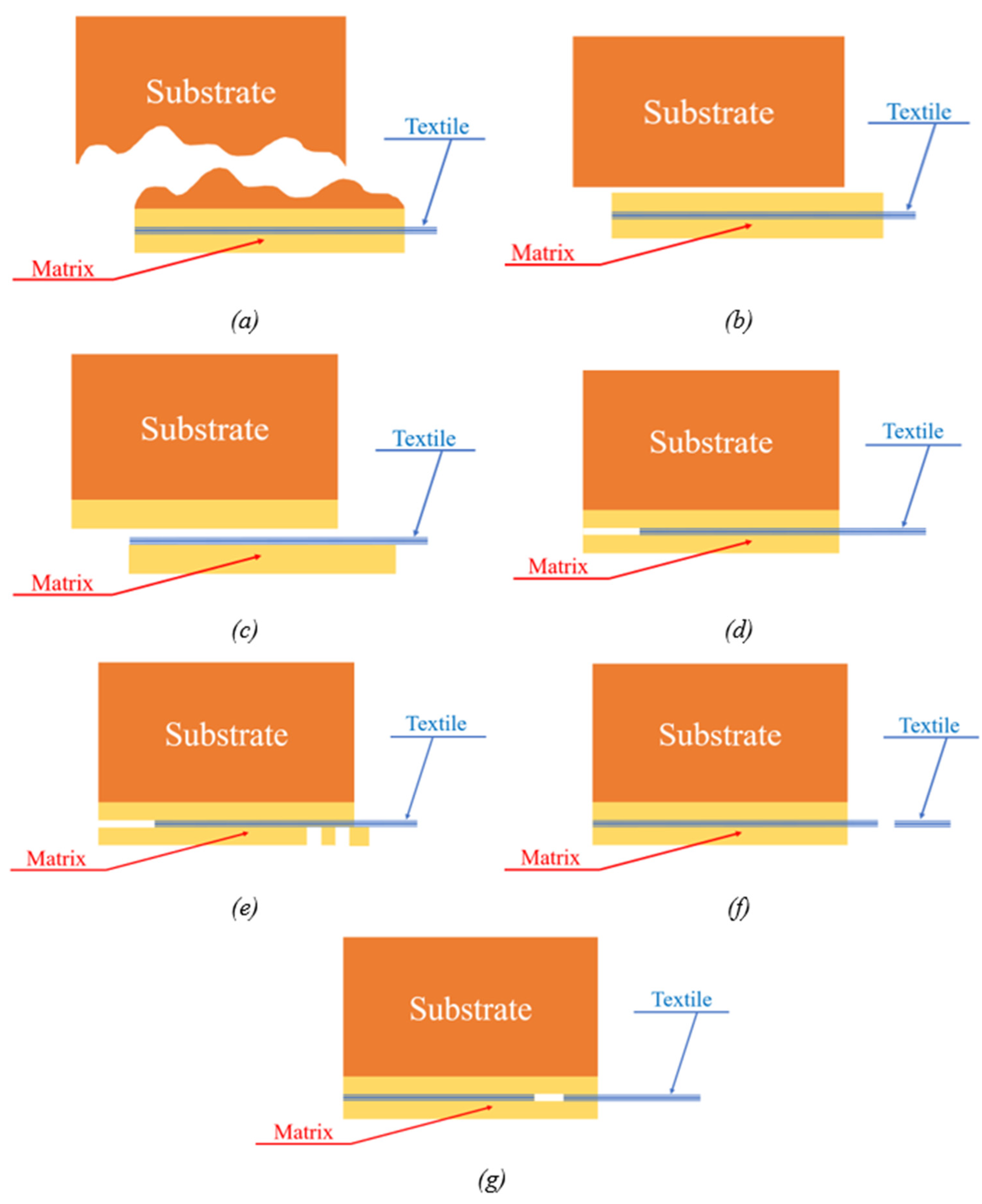
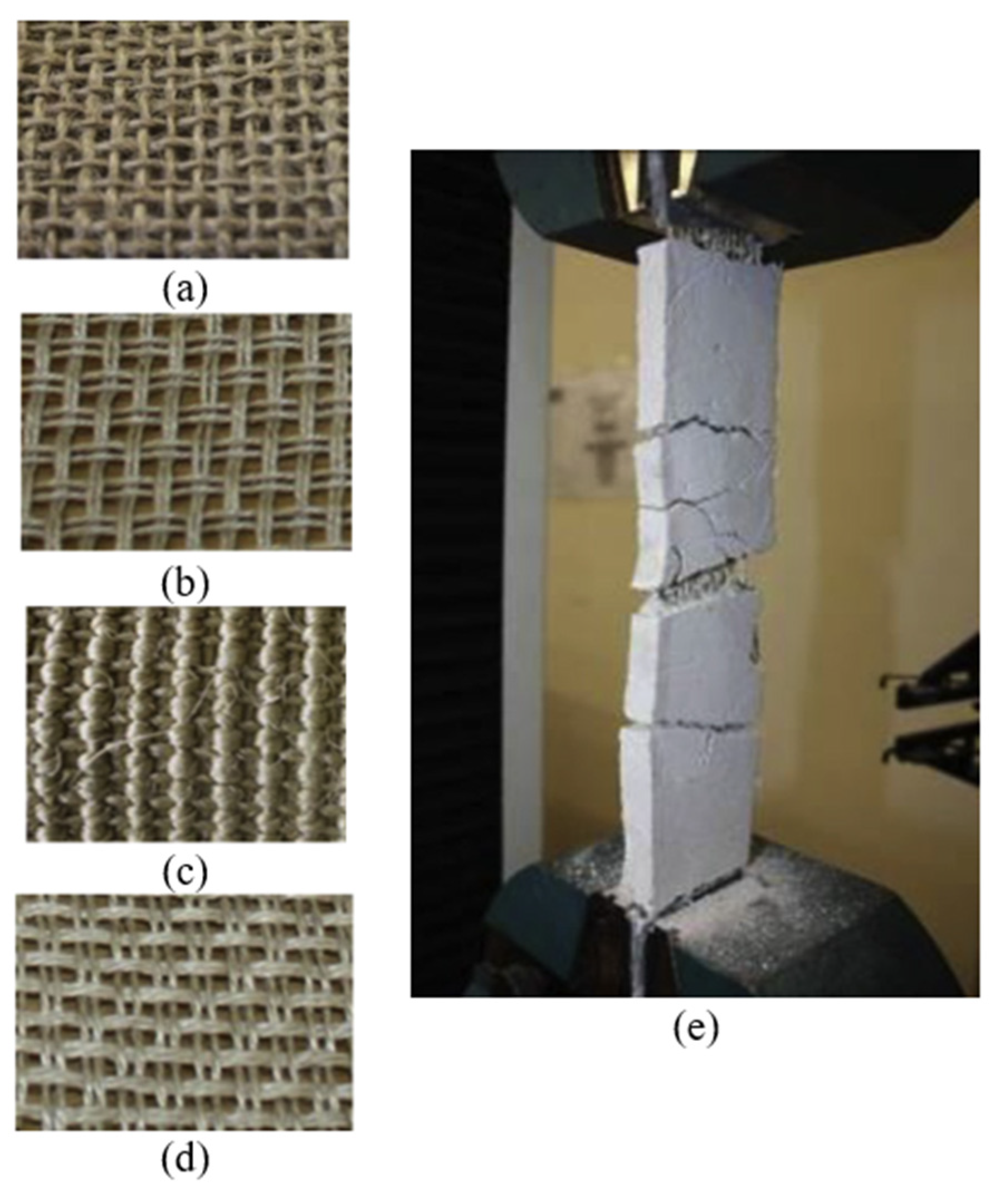

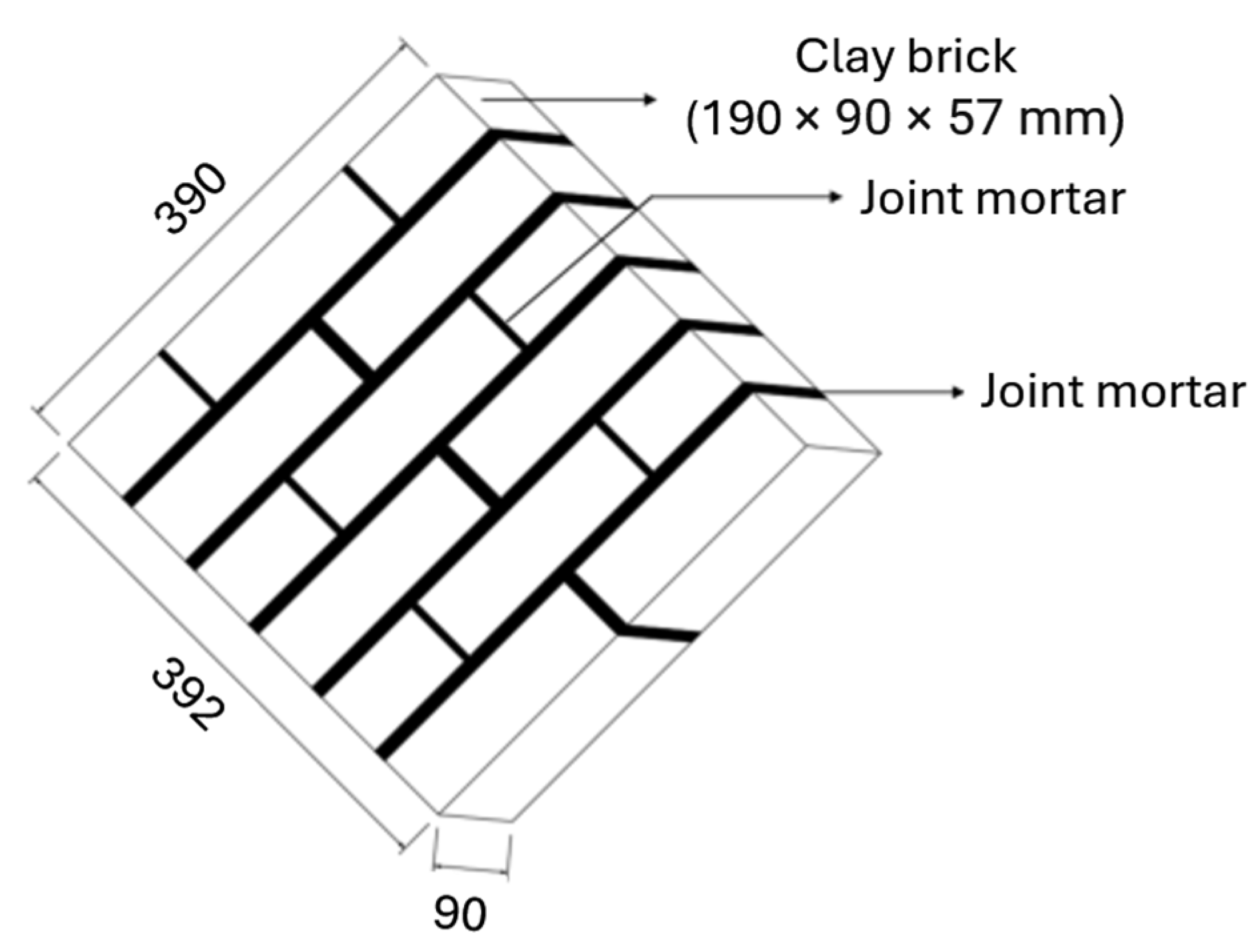
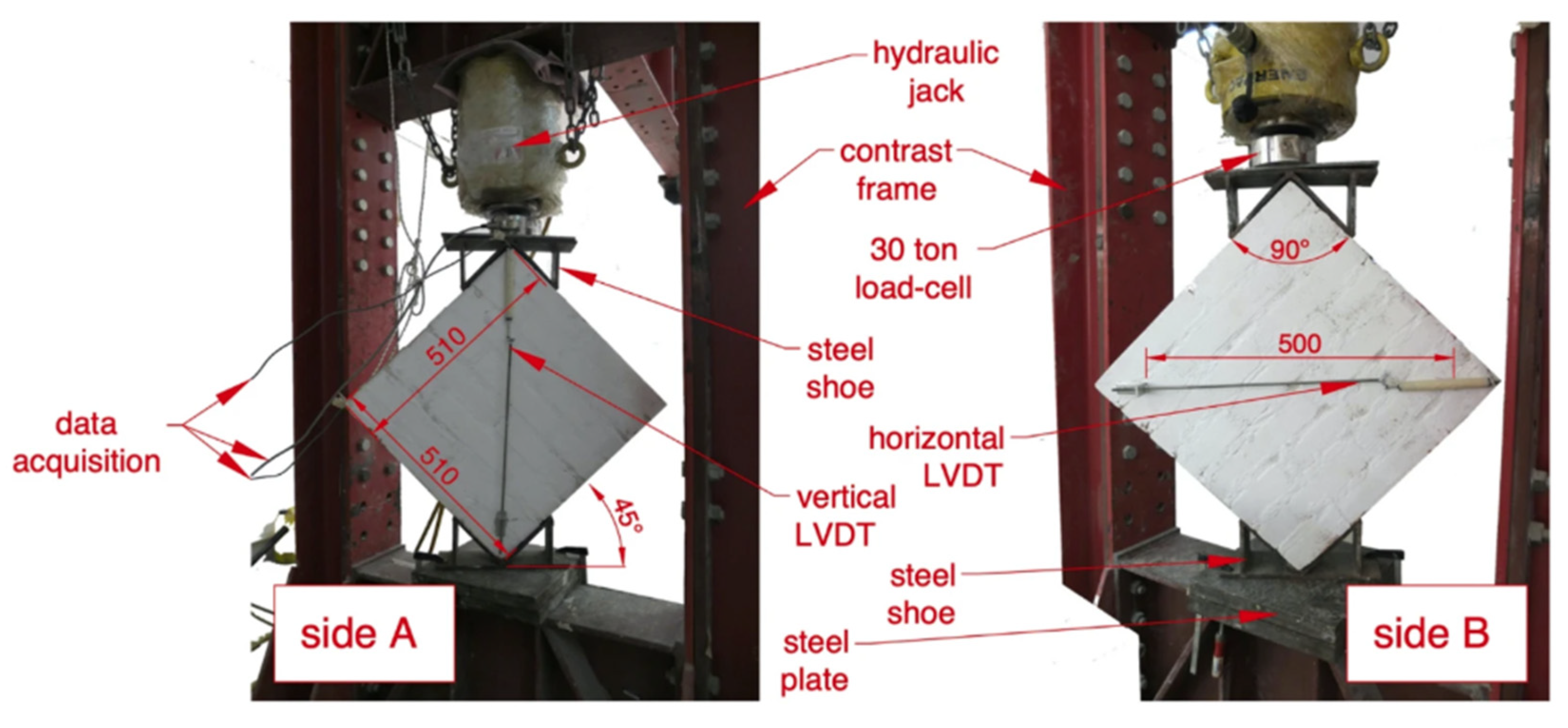
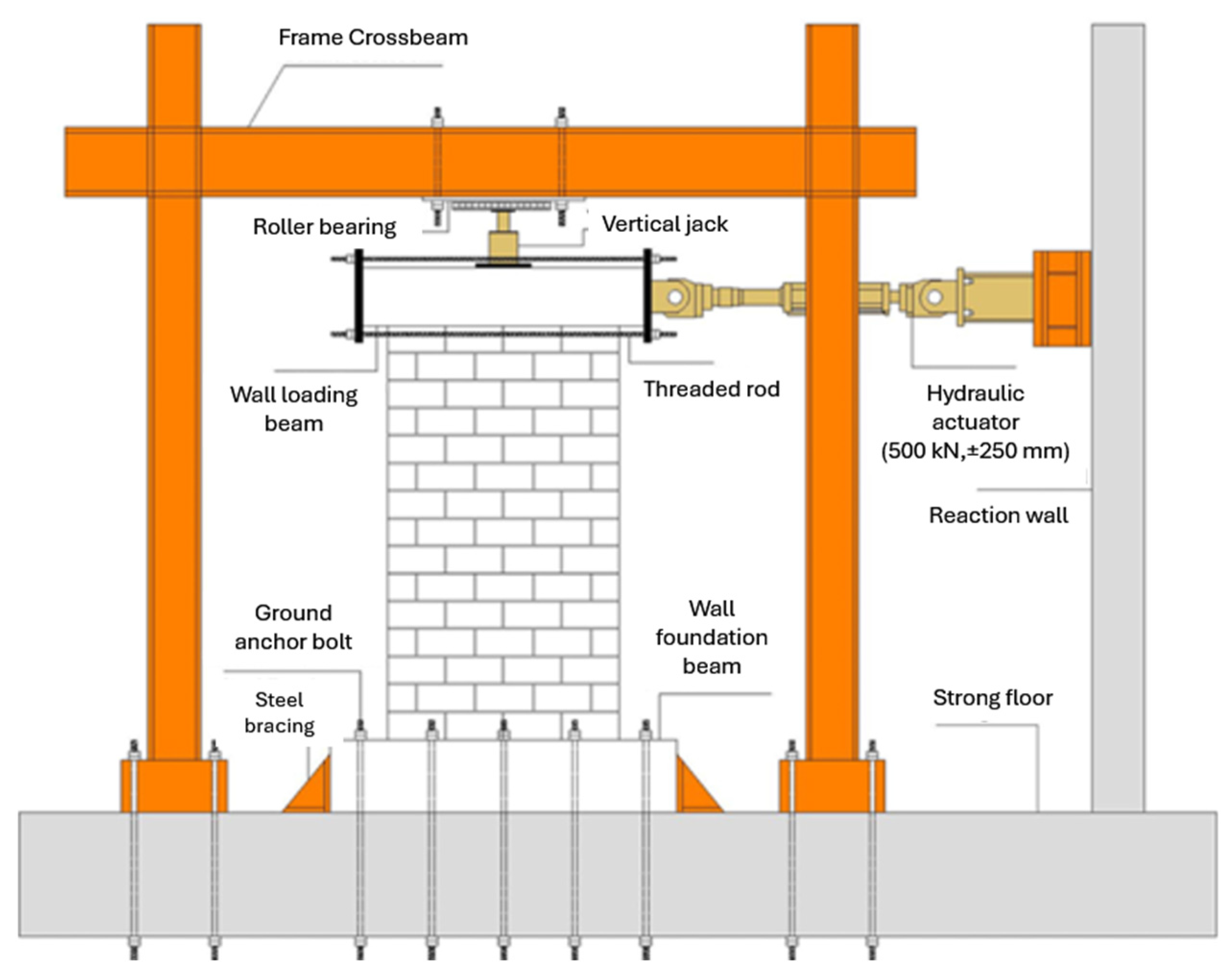
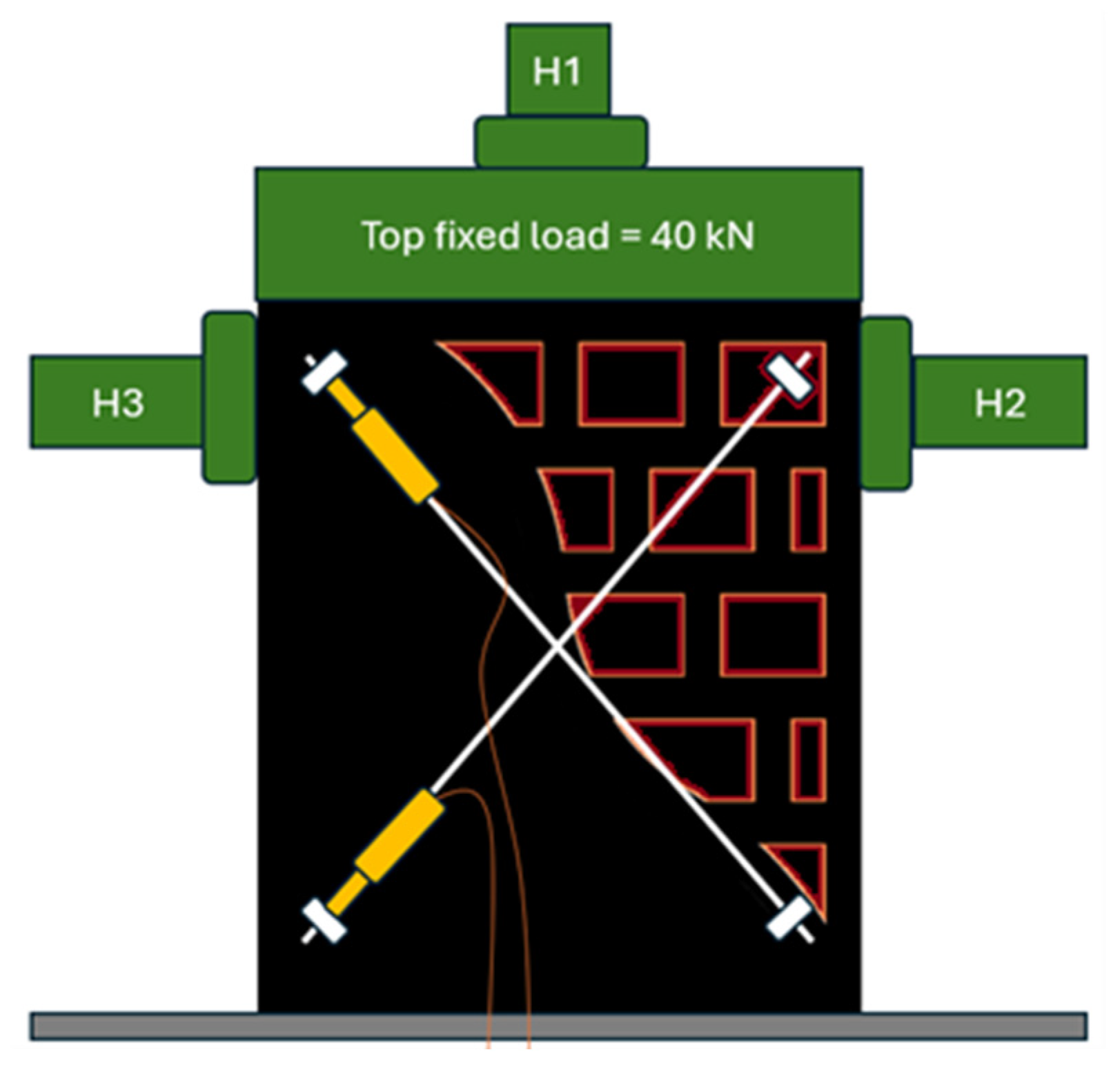
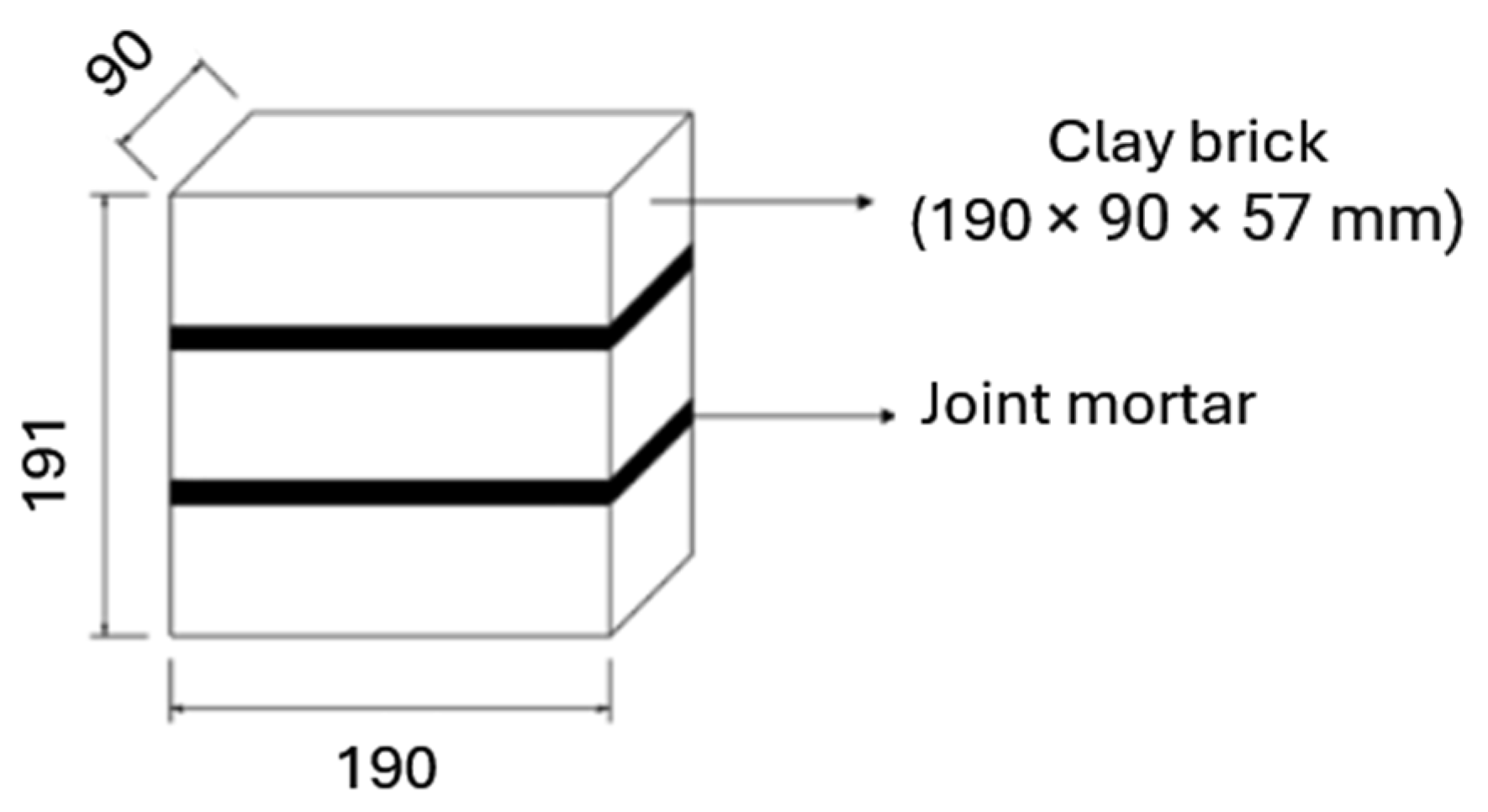
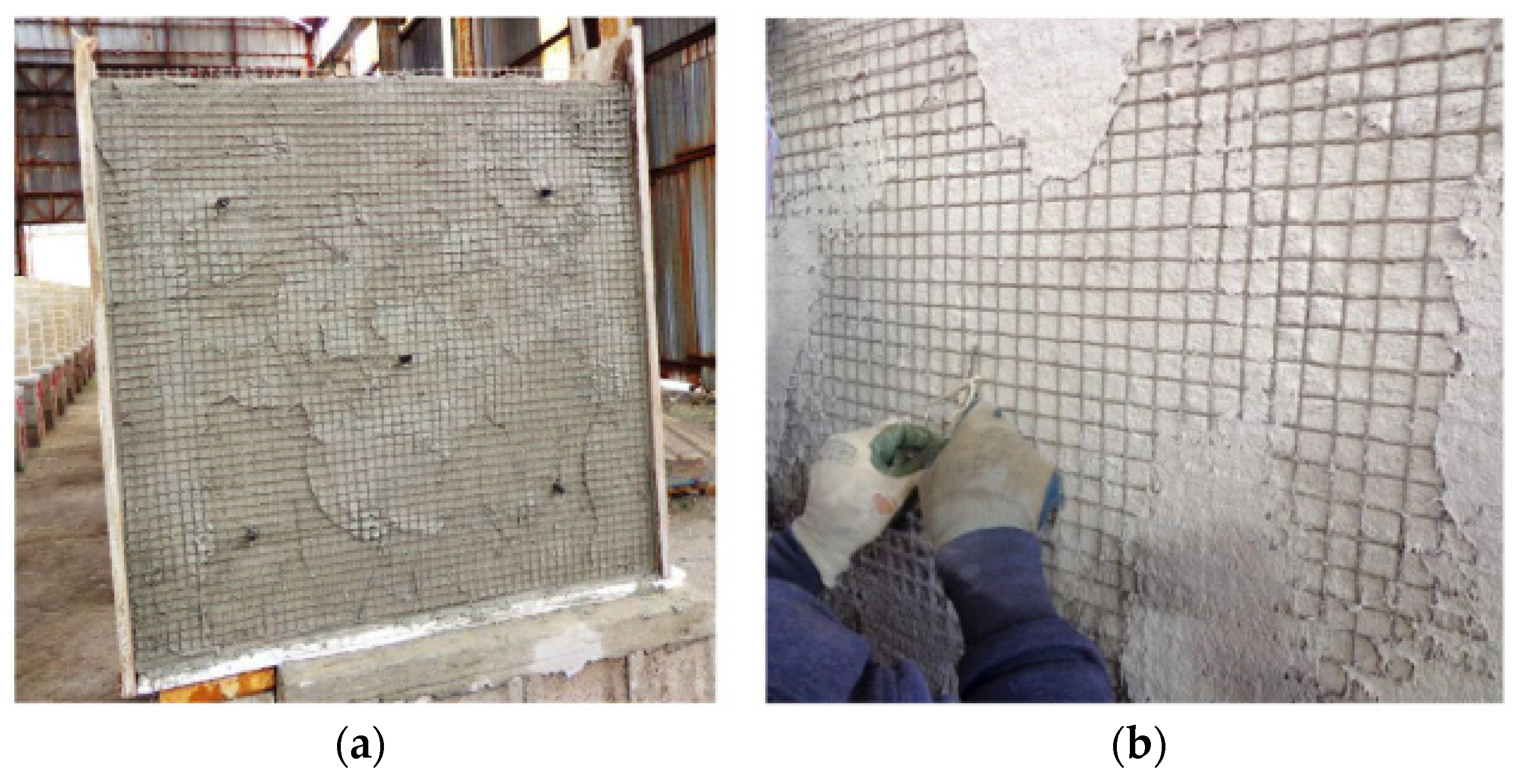


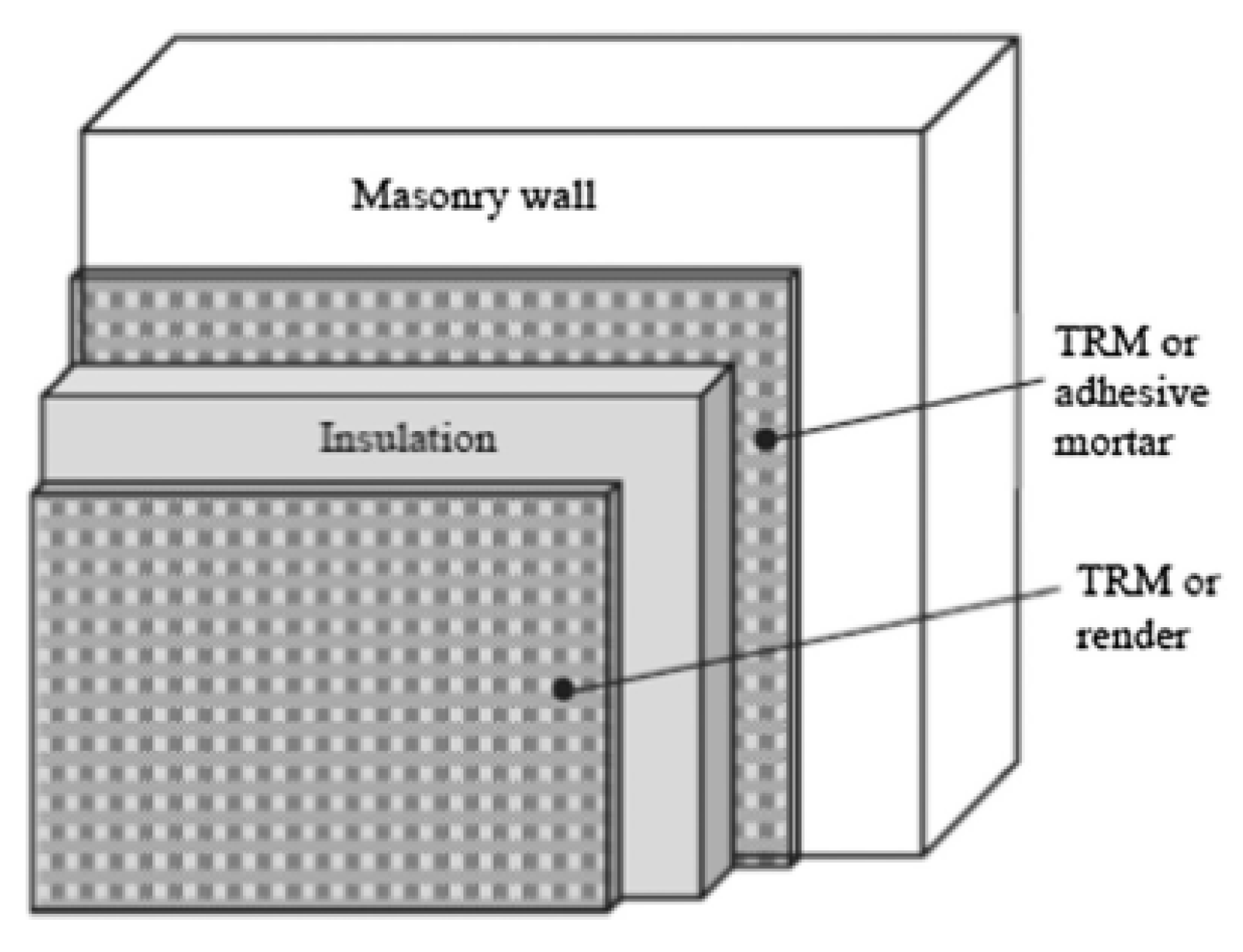
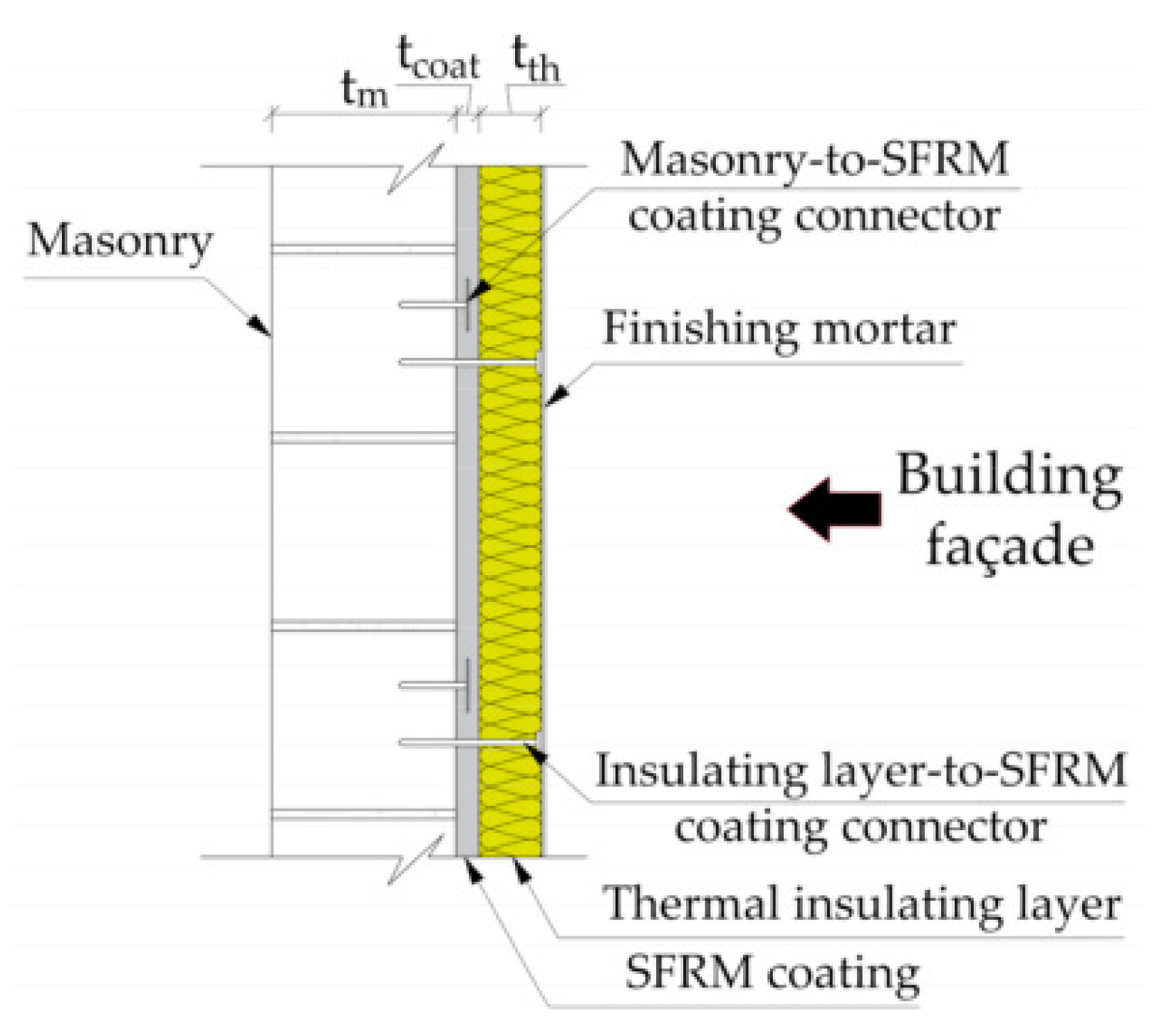
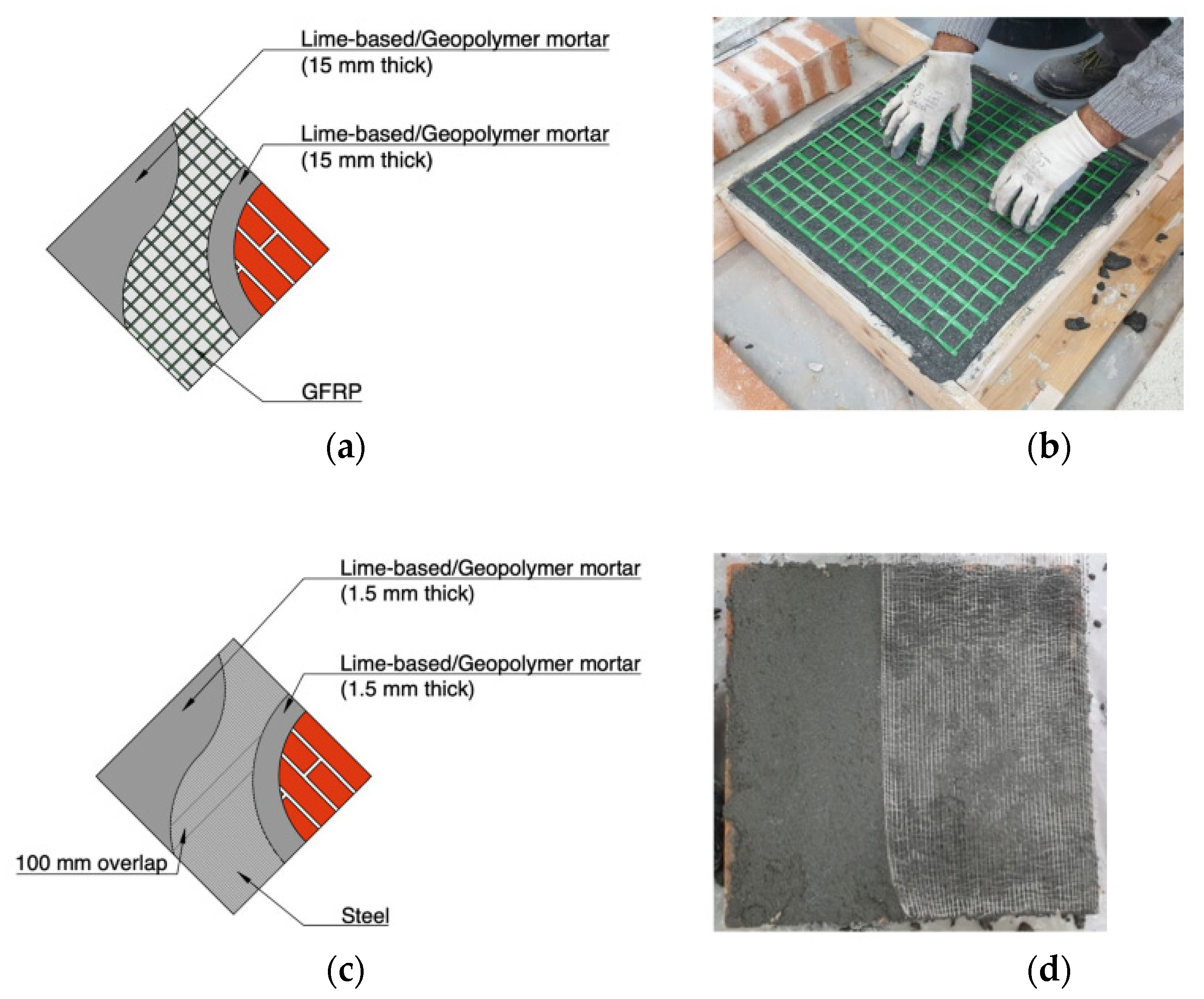

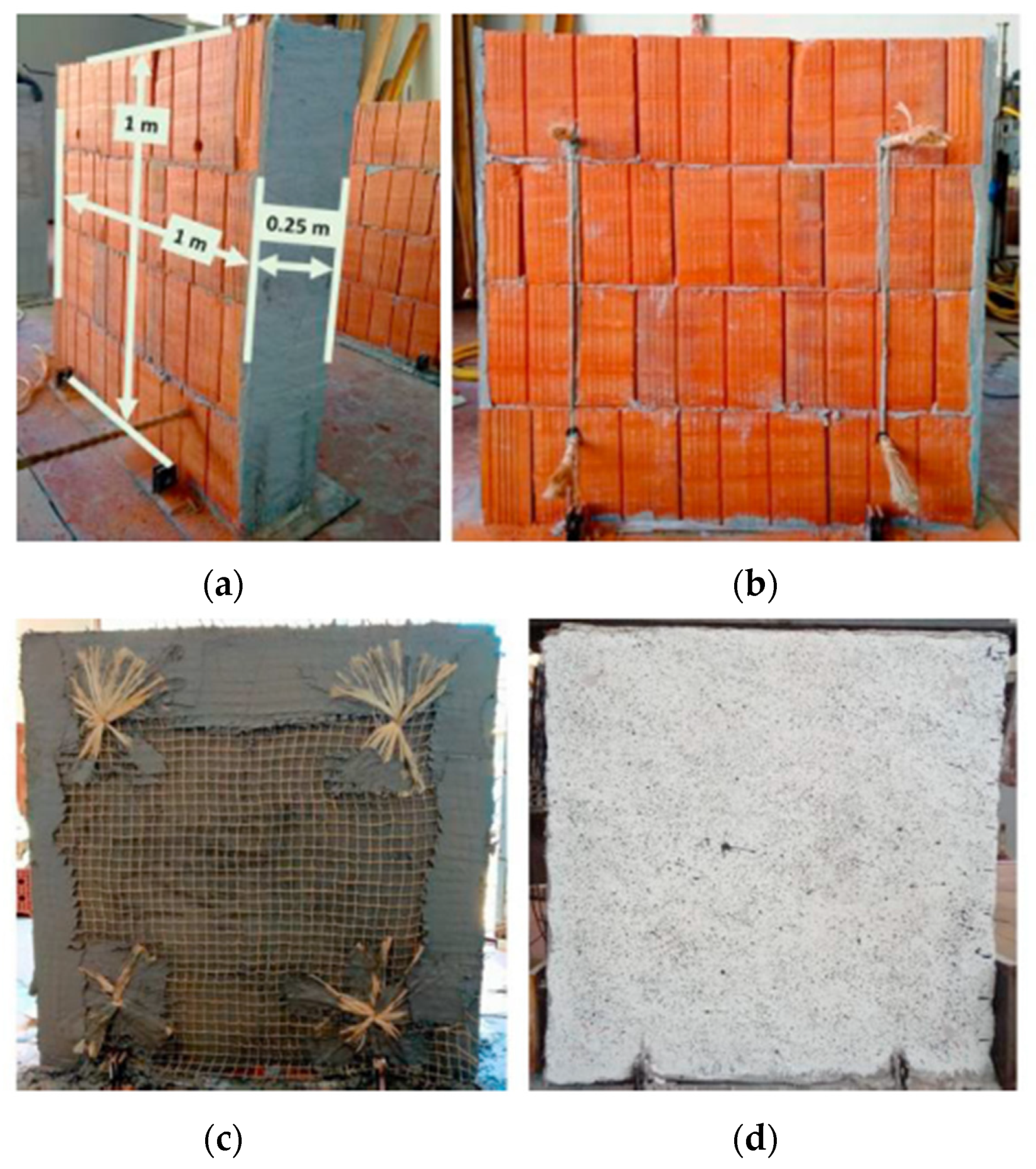

| Building Materials | Fiber and Mortar/Plaster Materials | TCavg. (W/mK) |
|---|---|---|
| Natural fiber composite retrofitting plasters | Sheep wool, thistle fibers, and lime putty | 0.180 |
| Sheep wool, thistle fibers, lime putty, and Opus signinum | 0.146 | |
| Sheep wool and lime putty | 0.257 | |
| Sheep wool, lime putty, and Opus signinum | 0.272 | |
| Natural fiber composite building insulation materials | Hemp shives and lime putty | 0.109 |
| Hemp shives, lime putty, and Opus signinum | 0.107 | |
| Hemp shives and clay | 0.138 |
| TRM | FRP |
|---|---|
| Inorganic matrix [9]. | Organic matrix [108]. |
| High strength-to-weight ratio enhances the mechanical performance [9]. | Much higher strength |
| Easily applicable and installed [42]. | Need special attention during application [109]. |
| No organic additives are needed (if used, ref. [9] recommends the weight of the inorganic binder should not exceed 10%). | Organic additives needed for its application [108]. |
| Ideal for countering limited deformations in masonry [9]. Employed primarily to the retrofitting/upgrading of elements or structures. | High specific strength makes it suitable for use as strip laminates [42]. |
| Stress is less concentrated due to the uniform application of TRM fabric over the masonry. | Concentration of stress and low adhesion capacity [42]. |
| Good chemical-physical compatibility between composite and masonry substrates [42]. | Polymeric resins commonly used are non-permeable, potentially causing compatibility issues between composites and masonry [42]. |
| Can retain its performance even at high temperatures [110]. | Lose effectiveness at high temperatures [110]. |
| Improve ductility [9]. | Lacks ductility and susceptibility to fire [42]. |
| TRM Application | Objective |
|---|---|
| Panels or whole wall surface (Figure 15) | to enhance the shear and combined axial and bending moment capacity. |
| Vaults and arches | to improve the tensile capacity of the structure. |
| Floor and roof ring beams | to increase the collapse multiplies. |
| Columns | to increase ductility. |
| Type of Natural Fiber Composite Mortar Used | Mechanical and Thermal Test Results | Ref. |
|---|---|---|
| Coconut fiber cementitious composites | Coconut fiber content increased from 0% to 4%. Flexural strength increased from 5.2 MPa to 7.4 MPa (28th day); Compressive strength decreased from 65 MPa to 33 MPa (28th day) and 69 MPa to 34 MPa (56th day). | Hwang et al. [136] |
| Banana fiber composite mortar | The optimal banana fiber content was 0.25% by weight of cement. Compressive strength (28th day) increased from 46.73 to 55.45 MPa; Flexural strength (28th day) increased from 8.45 to 10.98 MPa; Splitting tensile strength (28th day) increased from 4.48 to 6.32 MPa. | Lamichhane et al. [133] |
| Date palm fiber composite mortar | The compressive strength and the thermal conductivity both decreased with decreasing density, corresponding to increasing date palm fiber (DPF) content. At 5% DPF content (MDP mix): Compressive strength (Rc): 5 MPa, and thermal conductivity (k): 0.39 W/mK. Meets structural and insulating concrete standards (Rc > 3.5 MPa, k < 0.75 W/mK). | Benmansour et al. [34] |
| Hemp fiber composite mortar | The overall optimal results were obtained for 2–3% fiber (12 mm) combinations. The strength improved compared with the reference mortar. Compressive strength (28th day) increased from 27.94 to 36.46 MPa (for 3% + 18 mm fiber); with a minimum observed value of 23.62 MPa (for 1% + 6 mm fiber). Flexural strength (28th day) increased from 31.14 to 34.67 MPa (for 3% + 12 mm fiber); with a minimum of 28.31 (for 1% + 6 mm fiber). | Çomak et al. [134] |
| Bamboo fiber composite mortar | Compressive strength (28th day): reduced from 38.03 MPa (Reference) 10.14 MPa (9.6% Vol) and to 2.46 MPa (15% Vol). Flexural strength (28th day) reduced from about 3 MPa (9.6% Vol) to 1 MPa (15% Vol); Thermal conductivity dropped from 1.76 W/mK (reference) to 0.719 W/mK (for sample with 15% vol). | Tong et al. [137] |
| Wood fiber composite mortar | Compressive strength (28th day): Air–lime mortar: 0.41 MPa (Reference) to 0.58 MPa (for beech fiber) and 0.92 MPa (for pine fiber); Lime pozzolan mortar: 3.67 MPa (Reference) to 1.6 MPa (for beech fiber) and 3.01 MPa (for pine fiber); Cement-based mortar: 43.08 MPa (Reference) to 37.45 MPa (for beech fiber) and 38.42 MPa (for pine fiber). Flexural strength (28th day): Air–lime mortar: 0.07 MPa (Reference) to 0.15 MPa (for beech fiber) and 0.38 MPa (for pine fiber); Lime pozzolan mortar: 1.7 MPa (Reference) to 0.49 MPa (for beech fiber) and 0.99 MPa (for pine fiber); Cement-based mortar: 6.95 MPa (Reference) to 7.48 MPa (for beech fiber) and 6.31 MPa (for pine fiber). Thermal conductivity: Lime pozzolan mortar: 0.9591 W/mK (Reference) to 0.8006 W/mK (for beech fiber) and 0.6689 W/mK (for pine fiber); measured at 10 °C. 1.4325 W/mK (Reference) to 1.1679 W/mK (for beech fiber) and 1.1237 W/mK (for pine fiber); measured at 20 °C; Cement-based mortar: 1.0545 W/mK (Reference) to 0.7939 W/mK (for beech fiber) and 0.6848 W/mK (for pine fiber); measured at 10 °C. 1.5831 W/mK (Reference) to 1.3885 W/mK (for beech fiber) and 1.3020 W/mK (for pine fiber); measured at 20 °C. | Stefanidou et al. [138] |
| Pineapple fiber composite mortar | Compressive strength (28th day): 10.5 MPa (Reference), increased to 12 MPa (for 2%) and 14.5 MPa (for 5%), reduced to 9.5 MPa (for 10%) | Marvali et al. [135] |
| Sheep wool fiber composite mortar | Compressive strength (28th day): reduced with the increase of fiber percentage. 13% fiber, 20 mm fiber length: 2.8 MPa; 13% fiber, 6 mm fiber length: 4.171 MPa; 13% fiber, 1 mm fiber length: 0.914 MPa; 23% fiber, 6 mm fiber length: 0.743 MPa; 23% fiber, 1 mm fiber length: 0.571 MPa; 46% fiber, 1 mm fiber length: 0.171 MPa. Thermal conductivity: reduced with the increase of fiber percentage. 13% fiber, 20 mm fiber length: 0.191 W/mK; 13% fiber, 6 mm fiber length: 0.151 W/mK; 13% fiber, 1 mm fiber length: 0.244 W/mK; 23% fiber, 6 mm fiber length: 0.142 W/mK; 23% fiber, 1 mm fiber length: 0.149 W/mK; 46% fiber, 1 mm fiber length: 0.096 W/mK. | Valenza et al. [33] |
| Coconut coir (CC) composite mortar and CC + rice husk ash (RHA) composite mortar | Flexural strength: Increased by 8.6% with 0.5% CC fiber alone (always remaining above 7.5 MPa); increased by 13.6% when combined with 10% RHA. | Silva and Naveen [139] |
| Kenaf fiber composite mortar | Compressive strength (28th day): 15.2 MPa (Reference); the strength was reduced with 1% (Vf) fiber, 10 mm fiber length: 14.2 MPa; for 2% (Vf) fiber, 10 mm fiber length: 18.44 MPa; 3% (Vf) fiber & 10 mm fiber length: 15.5 MPa. | Tope et al. [140] |
| Jute fiber composite mortar | The flexural strength, compression strength, and thermal conductivity reduced with the increase of fiber percentage. Flexural strength (28th day): 7.8 MPa (Reference); for composite mortar, the maximum value obtained was about 6.3 MPa (with 0.5% fiber and 30 mm fiber length) and minimum value obtained about 2.4 MPa (with combination 2% fiber and 5 mm fiber length). Compressive strength (28th day): 32.25 MPa (Reference); for composite mortar, the maximum value obtained was about 26.75 MPa (with 0.5% fiber and 10 mm fiber length) and the minimum value obtained was about 6.03 MPa (with 2% fiber and 5 mm fiber length). Thermal conductivity (28th day): 0.759 W/mK @ 10 °C, 0.771 W/mK @ 20 °C, 0.793 W/mK @ 30 °C (Reference); for composite mortar, the minimum value obtained was about 0.437 W/mK @ 10 °C (with combination 2% fiber and 10 mm fiber length) and the maximum value obtained was about 0.68 W/mK @ 30 °C (with 0.5% fiber and 30 mm fiber length). | Majumder et al. [55] |
| TRM Type and Material | Structural Performance (St.P) Obtained Values | Thermal Performance (Th.P) Obtained Values | Test Performed | Ref. |
|---|---|---|---|---|
| Natural Fiber TRM (NFTRM) package system (which includes all jute fiber) | Peak load obtained: Reference wall: 35.21 (kN). Upgraded wall: 236.21 (kN) | Thermal transmittance value: Reference wall: 1.77 (W/m2K) Upgraded masonry wall: 1.135 (W/m2K) | For St.P: In-plane cycling test. For Th.P: Evaluation of thermal transmittance in a climate chamber. | Stochino et al. [132] |
| Man-made fiber TRM (Note: EPS was used as the thermal retrofitting material) | Reference wall: 3.42 (kN). Upgraded masonry walls (max.): 20.26 (kN) | Considered an improvement in insulation property due to the presence of EPS | For St.P: Out-of-plane cyclic test. For Th.P: No tests were performed. | Triantafillou et al. [124] |
| Glass Fiber TRM (Note: EPS was used as the thermal retrofitting material) | Peak load obtained Reference wall: 19.9 (kN) for type A, 20 (kN) for type B, and 12.2 (kN) for type C Upgraded wall samples (max.): 37.5 (kN) for type A, 37.1 (kN) for type B and 36.8 (kN) for type C | Considered an improvement in insulation property due to the presence of EPS | For St.P: In-plane cyclic test. For Th.P: No tests were performed. | Triantafillou et al. [125] |
| Man-made fiber TRM; (Note: EPS was used as the thermal retrofitting material) | Reference wall (in-plane): 0.78 (kN). Upgraded masonry wall: 1.63 (kN). Reference wall (Out-of-plane): 1.60 (kN). Upgraded masonry wall: 25.3 (kN). | Considered an improvement in insulation property due to the presence of EPS | For St.P: In-plane shear and out-of-plane shear tests For Th.P: No tests were performed. | Gkournelos et al. [126] |
| Glass Fiber TRM (Note: EPS was used as the thermal retrofitting material) | Peak load obtained Reference wall: 3.42 kN Upgraded masonry wall (max.): 20.26 (kN) | Considered an improvement in insulation property due to the presence of EPS | For St.P: Out-of-plane cyclic test For Th.P: No tests were performed. | Karlos et al. [127] |
| Steel Fiber TRM; | Peak load obtained Reference wall: 180 (kN) Upgraded masonry wall (max.): 605 (kN) | Obtained thermal transmittance value: Reference wall: 1.038 (W/m2K). Upgraded masonry walls (analytical min.): 0.242 (W/m2K) Upgraded masonry walls (numerical min.): 0.246 (W/m2K) | For St.P: Two horizontal cyclic forces For Th.P: No tests were performed. | Facconi et al. [130] |
| AR dry Glass, Glass, Steel Fiber TRM | Reference wall (experimental): 46.19 (kN) (avg.) Upgraded masonry wall (max. among all combinations): 129.58 (kN) | Reference wall (experimental): 2.082 (W/m2K). Upgraded masonry wall (experimental min.): 1.051 (W/m2K). | For St.P: Diagonal shear tests For Th.P: Thermal transmittance test. | Longo et al. [118] |
| Basalt Fabric TRM + Textile capillary tube pane (TCP) | Lateral load capacity: Reference wall: 52.7 (kN). Upgraded masonry wall (max.): 119.15 (kN). | Maintained indoor temp ~20 °C; better performance with internal layer. | For St.P: Lateral load For Th.P: Measurement and evaluation of internal comfort | Baek et al. [128] |
| Man-made TRM (Note: EPS was used as the thermal retrofitting material) | Reference wall (in-plane): 140 (kN). Upgraded masonry wall: 160 (kN). Reference wall (Out-of-plane): 47.4 (kN). Upgraded masonry wall: 69.2 (kN). | Considered an improvement in insulation property due to the presence of EPS | For St.P: In-plane and out-of-plane For Th.P: No tests were performed. | Gkournelos et al. [129] |
| Glass Fiber TRM (Note: EPS, ETICS, RTIM was used as the thermal retrofitting material) | Reference wall (Out-of-plane): 45 (kN). Upgraded masonry wall (max.): 100 (kN). | Reference wall (calculated): 1.75 (W/m2K). Upgraded masonry walls (calculated min.): 0.242 (W/m2K) | For St.P: Out-of-plane For Th.P: No tests performed | Furtado et al. [130] |
Disclaimer/Publisher’s Note: The statements, opinions and data contained in all publications are solely those of the individual author(s) and contributor(s) and not of MDPI and/or the editor(s). MDPI and/or the editor(s) disclaim responsibility for any injury to people or property resulting from any ideas, methods, instructions or products referred to in the content. |
© 2025 by the authors. Licensee MDPI, Basel, Switzerland. This article is an open access article distributed under the terms and conditions of the Creative Commons Attribution (CC BY) license (https://creativecommons.org/licenses/by/4.0/).
Share and Cite
Majumder, A.; Stochino, F.; Valdes, M.; Concu, G.; Pepe, M.; Martinelli, E. Sustainable Masonry Retrofitting and Upgrading Techniques: A Review. Fibers 2025, 13, 68. https://doi.org/10.3390/fib13060068
Majumder A, Stochino F, Valdes M, Concu G, Pepe M, Martinelli E. Sustainable Masonry Retrofitting and Upgrading Techniques: A Review. Fibers. 2025; 13(6):68. https://doi.org/10.3390/fib13060068
Chicago/Turabian StyleMajumder, Arnas, Flavio Stochino, Monica Valdes, Giovanna Concu, Marco Pepe, and Enzo Martinelli. 2025. "Sustainable Masonry Retrofitting and Upgrading Techniques: A Review" Fibers 13, no. 6: 68. https://doi.org/10.3390/fib13060068
APA StyleMajumder, A., Stochino, F., Valdes, M., Concu, G., Pepe, M., & Martinelli, E. (2025). Sustainable Masonry Retrofitting and Upgrading Techniques: A Review. Fibers, 13(6), 68. https://doi.org/10.3390/fib13060068











